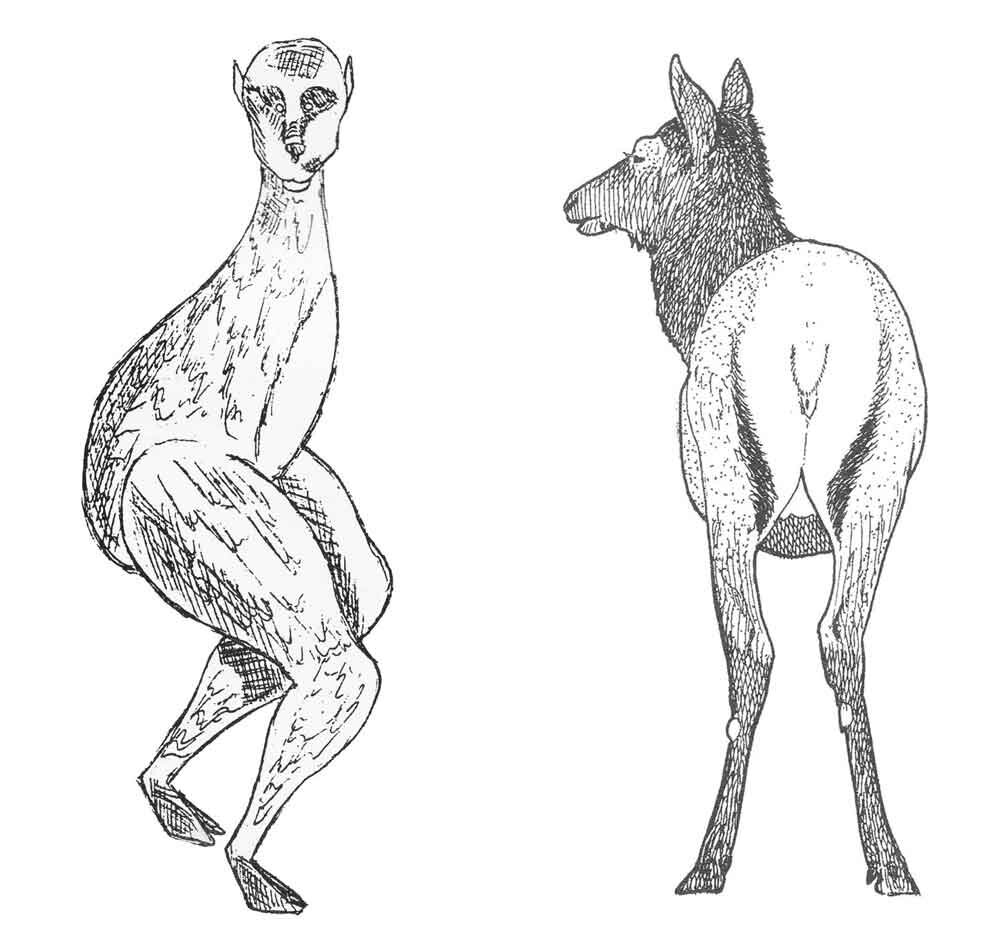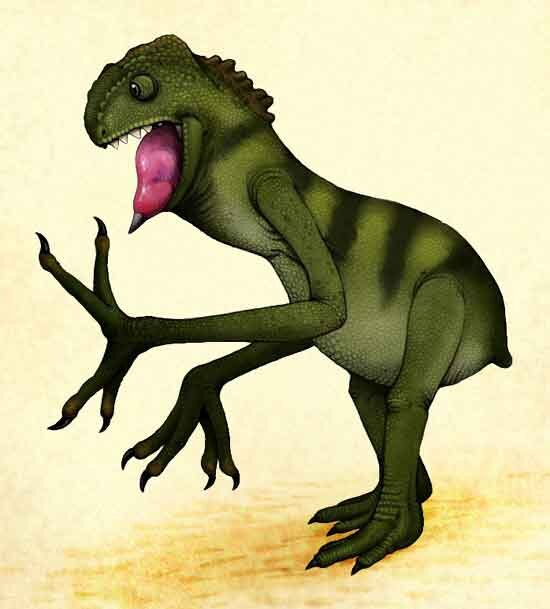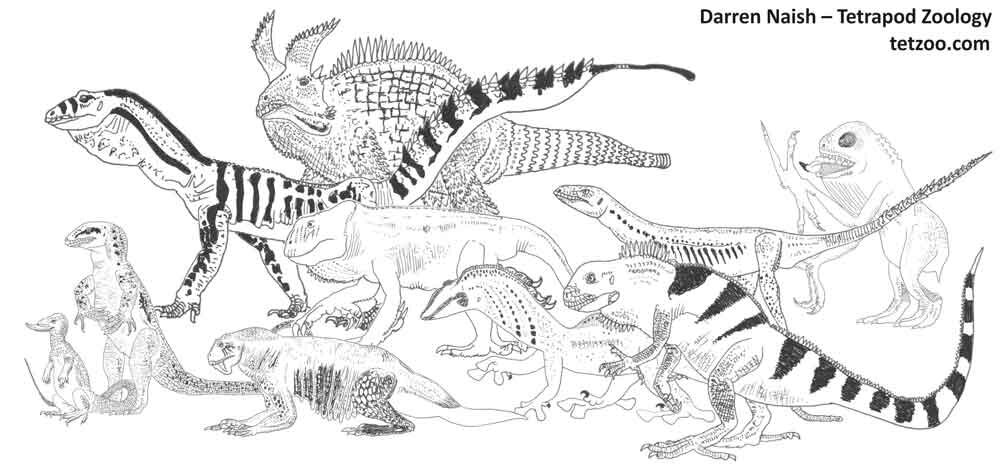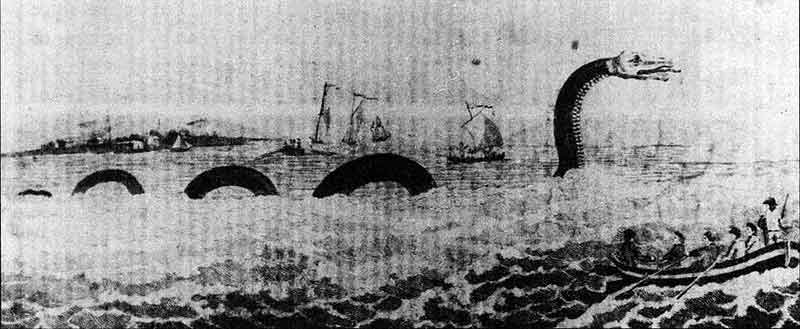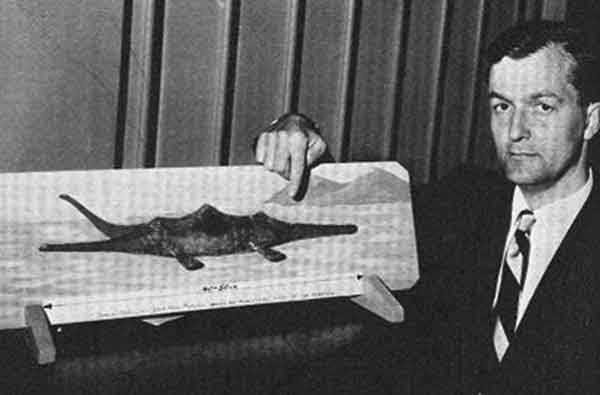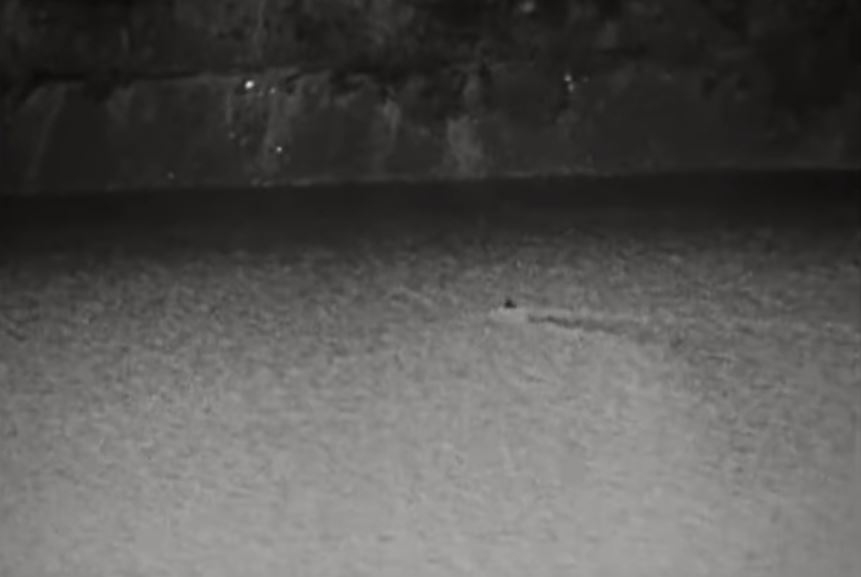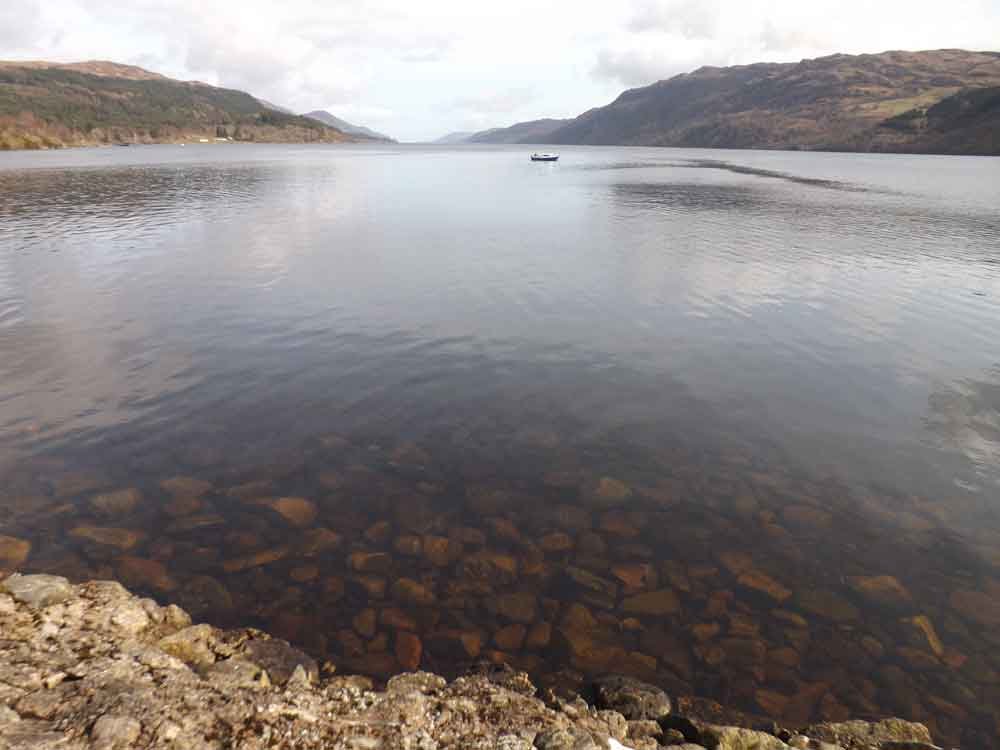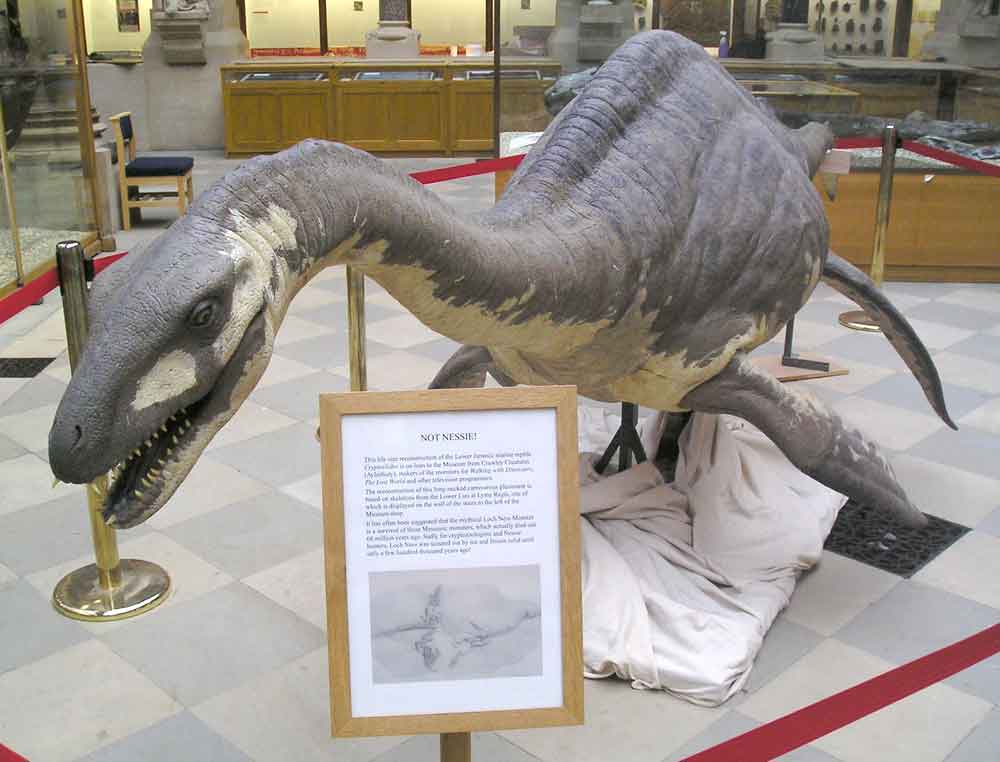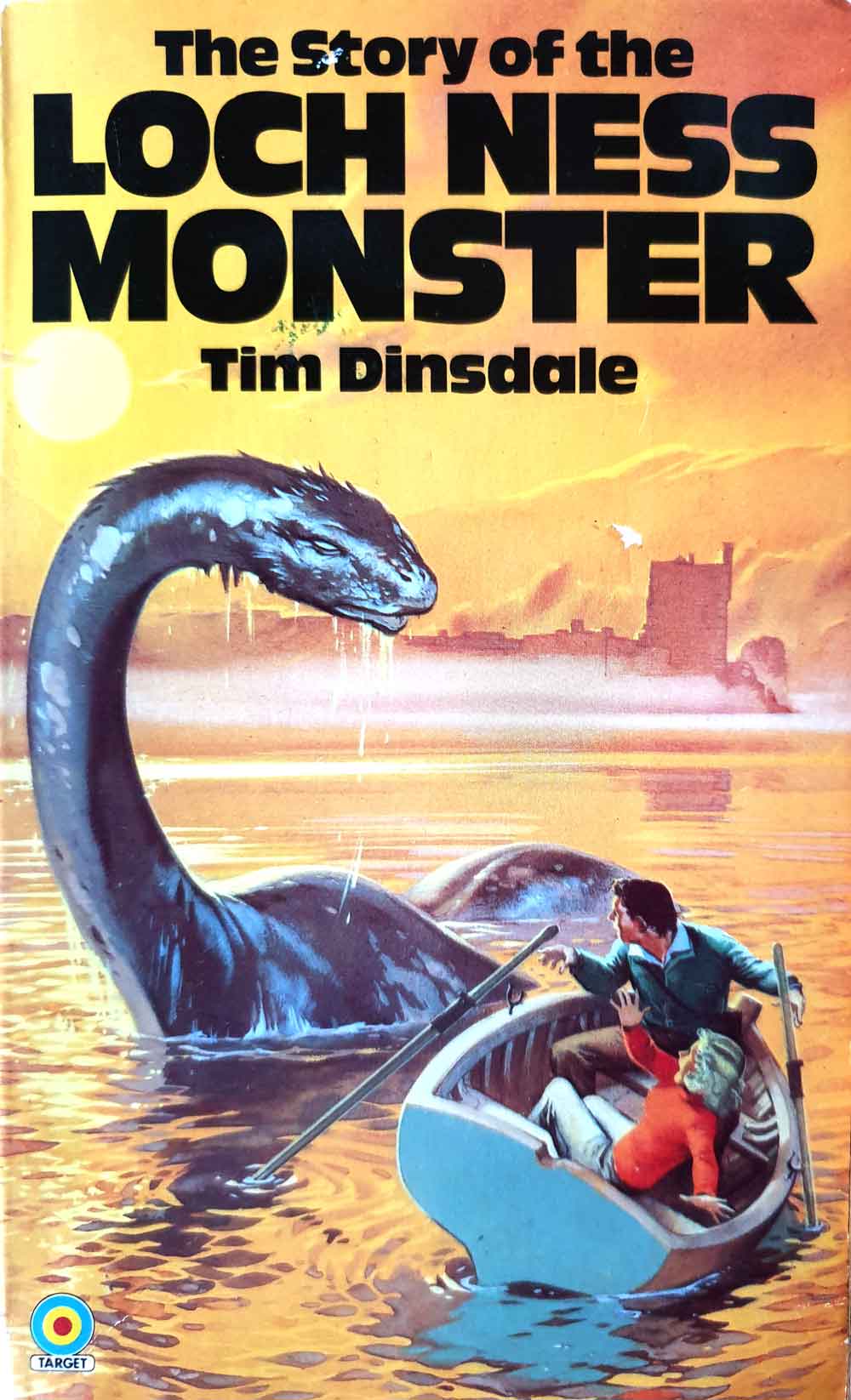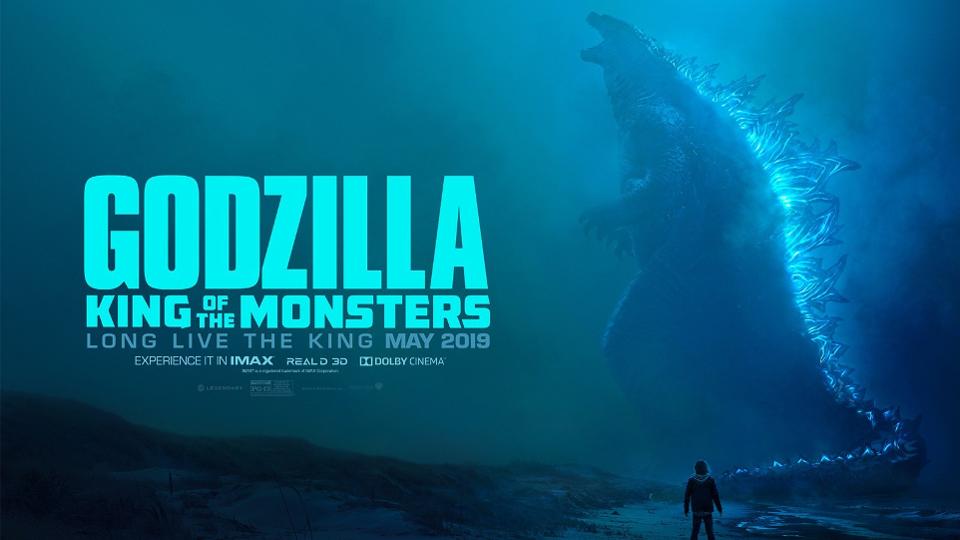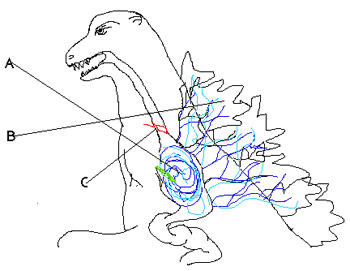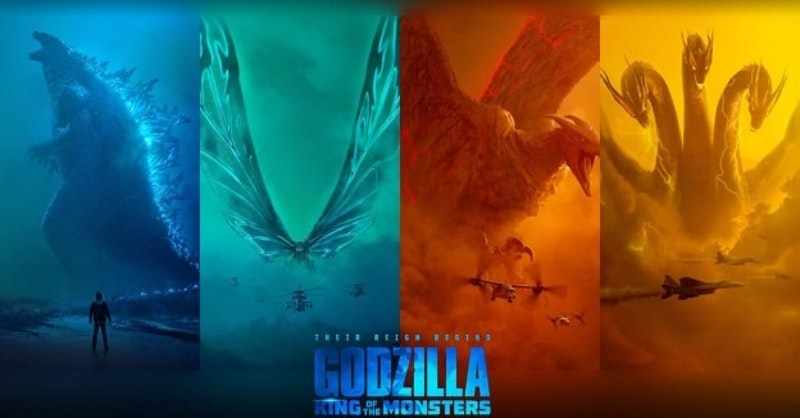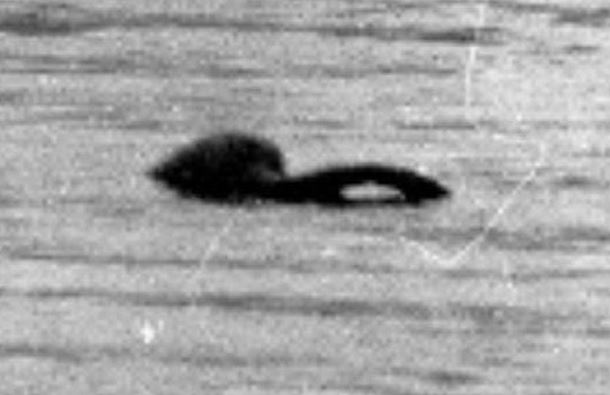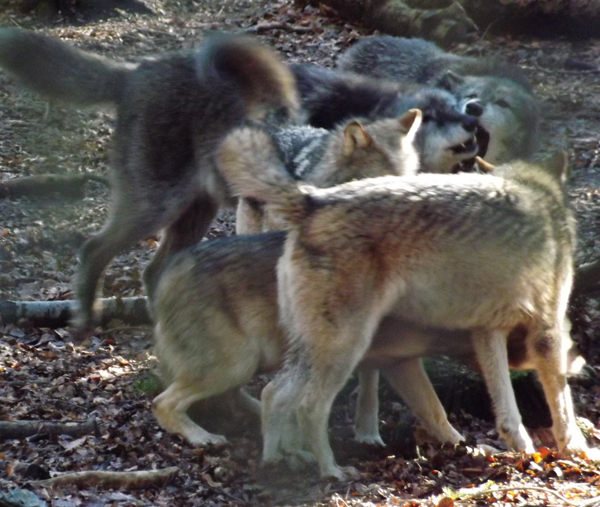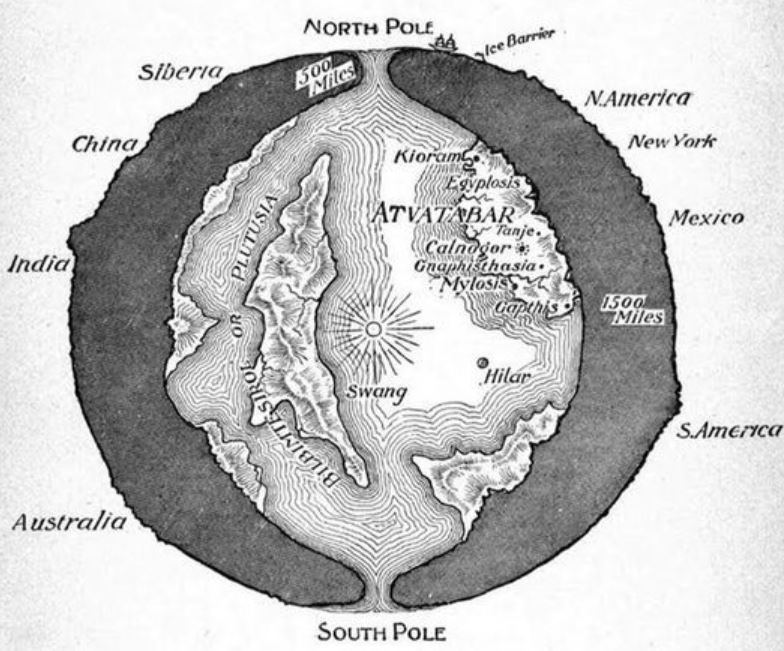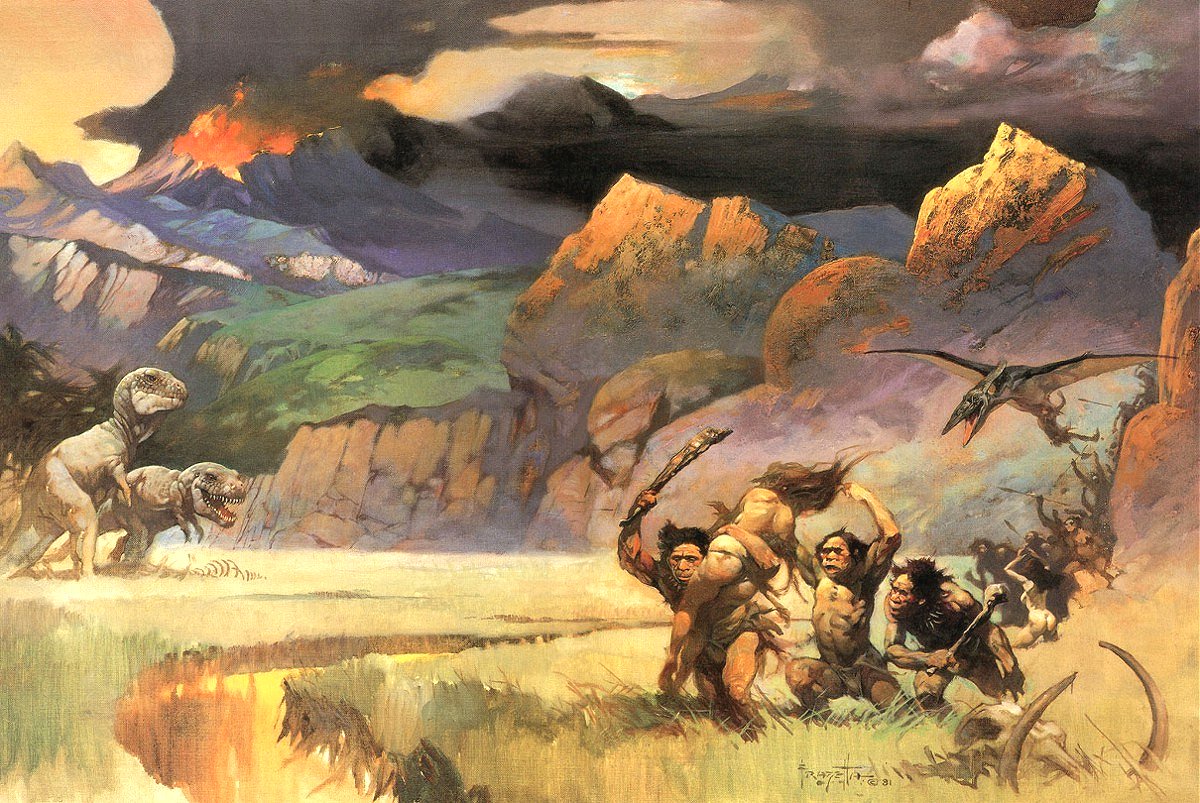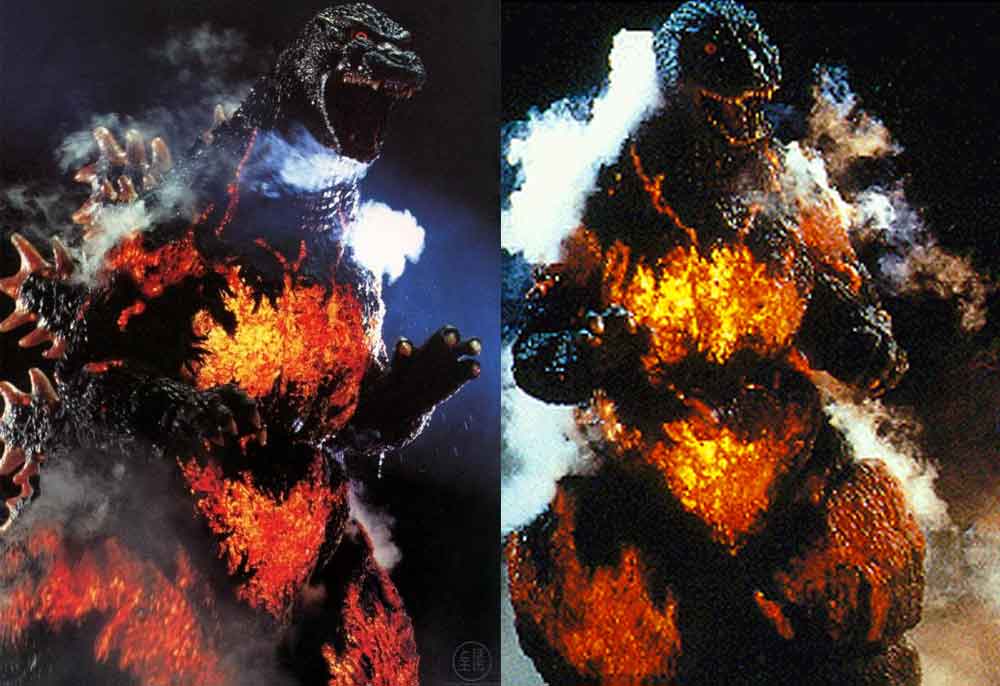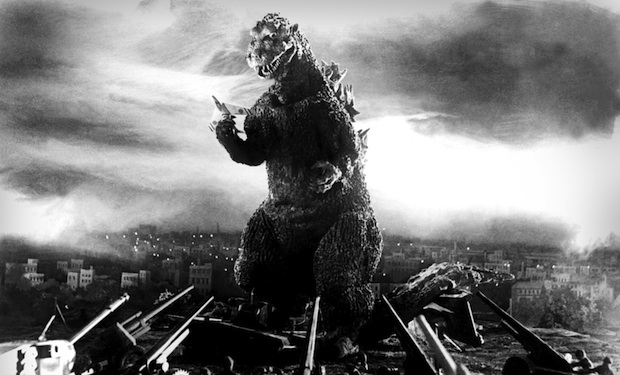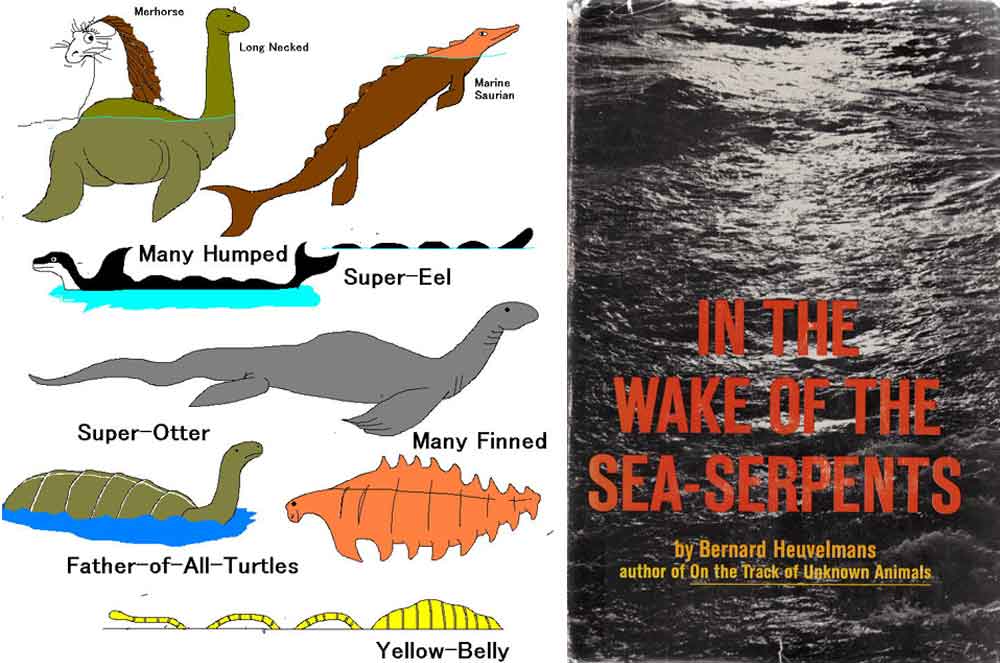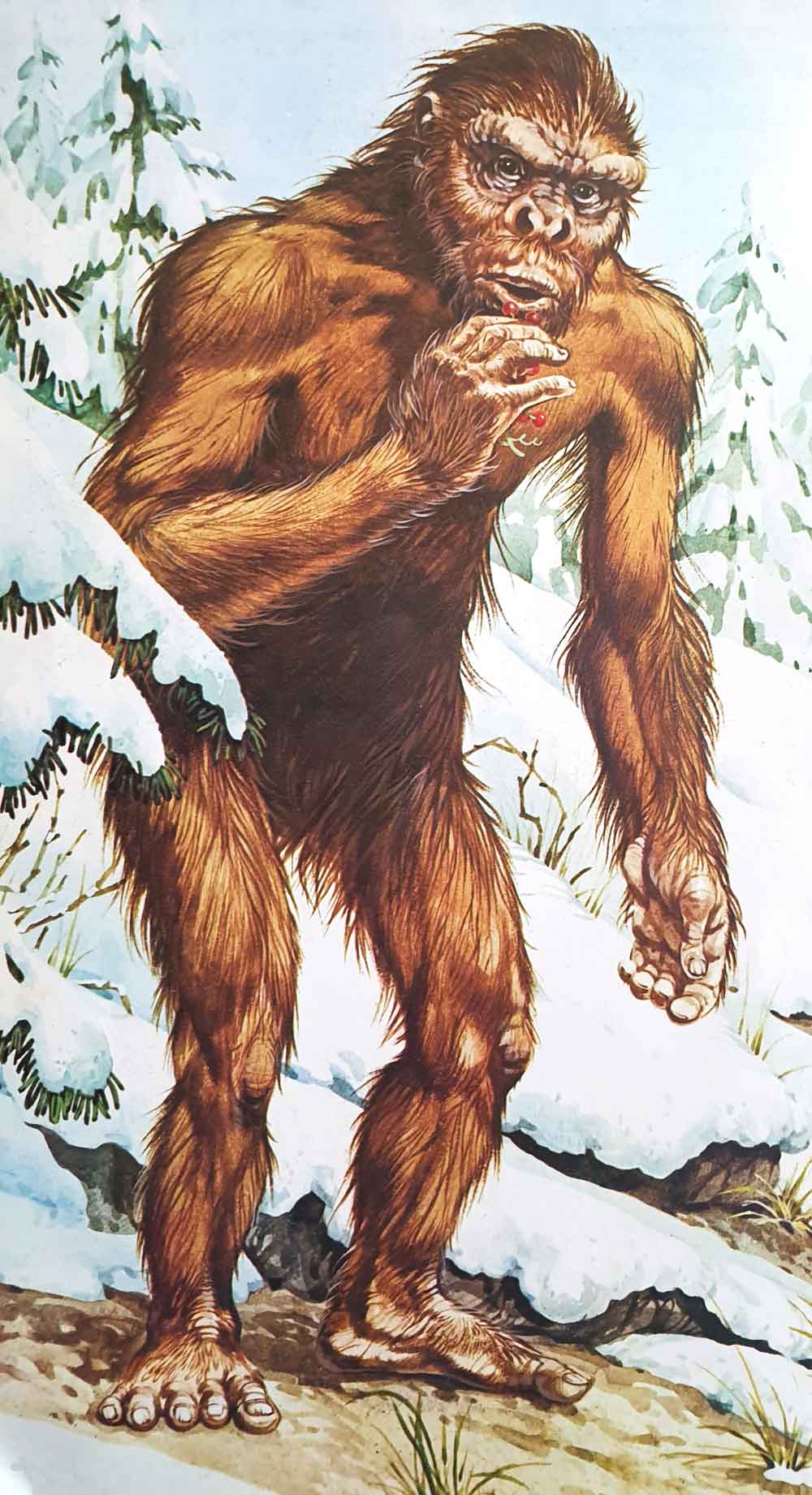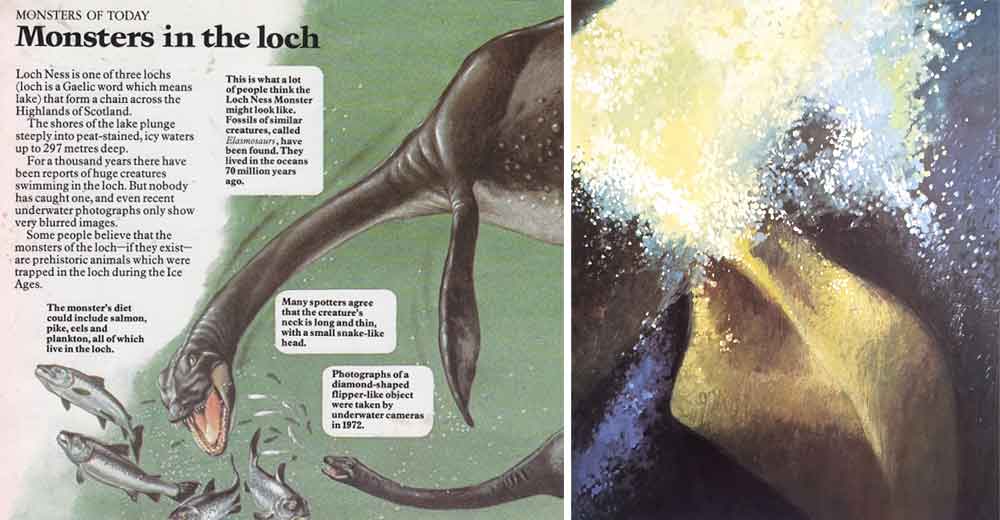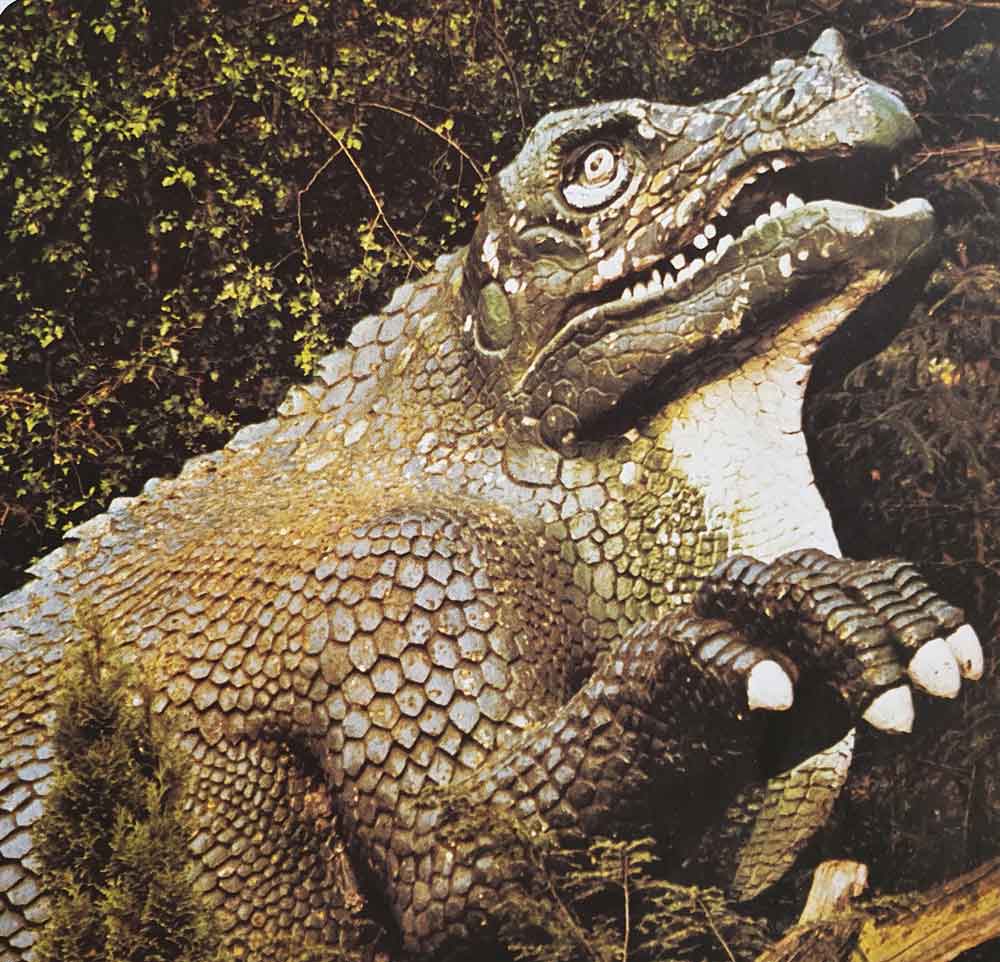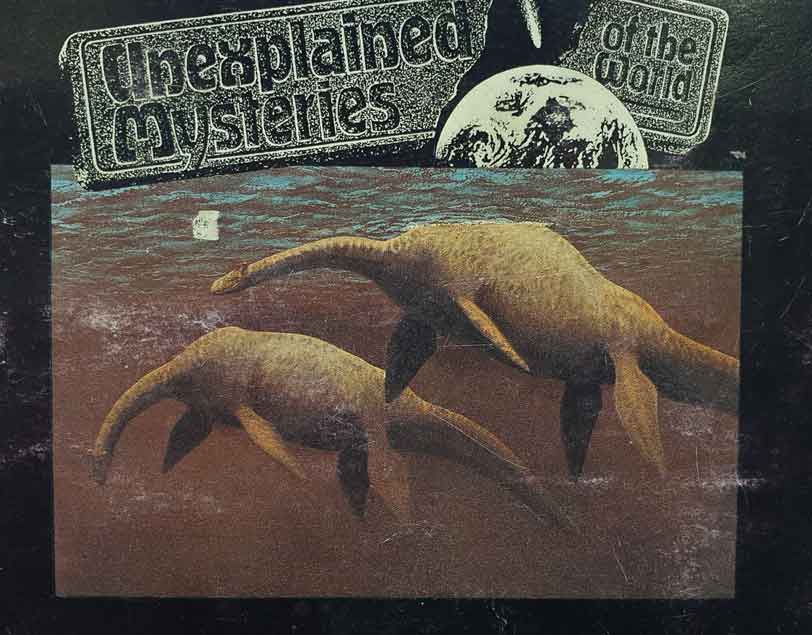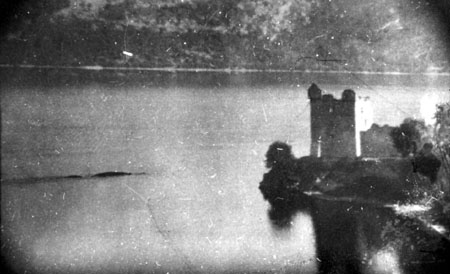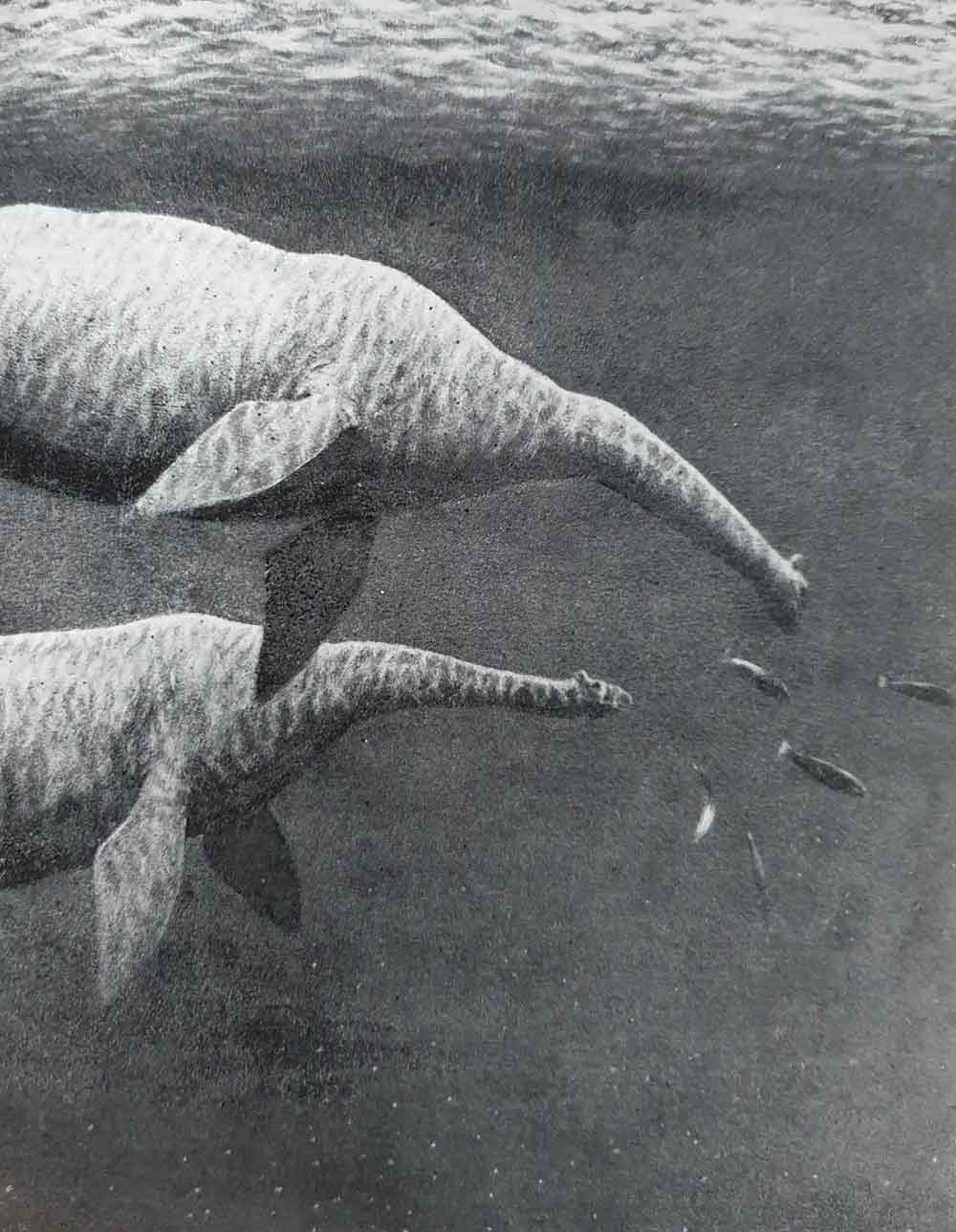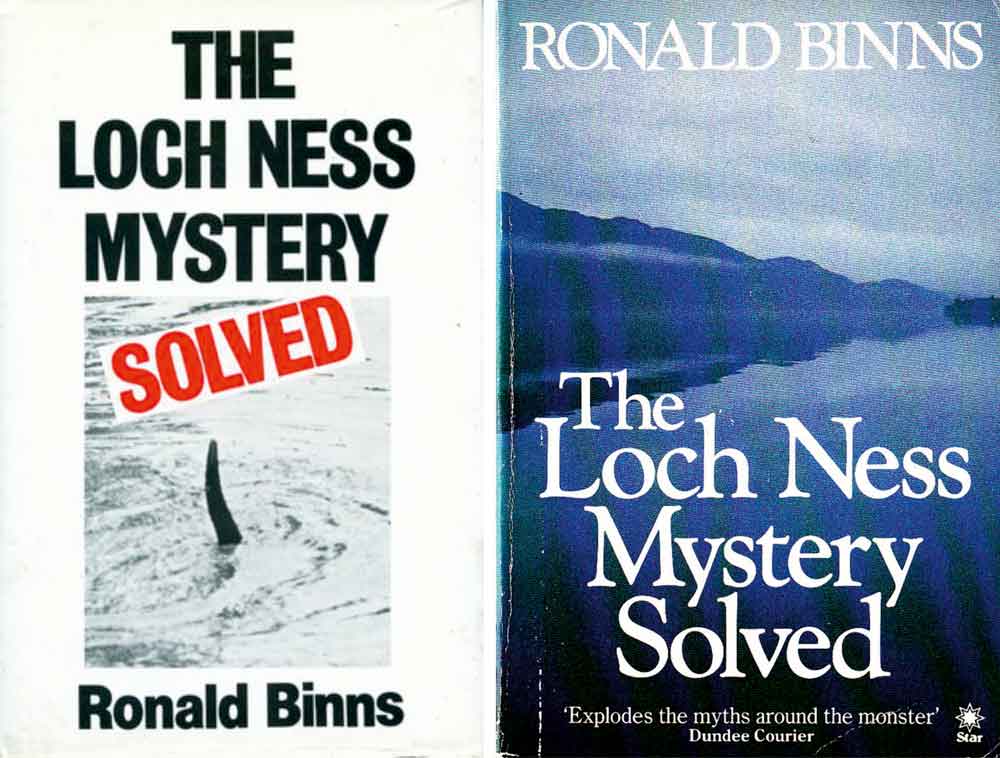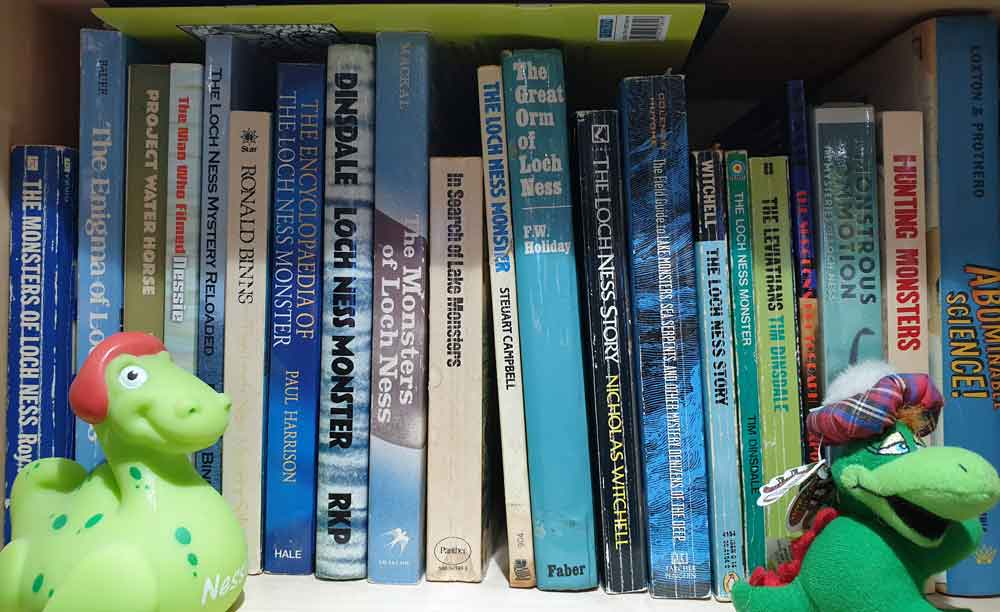Time for the second part in my Minnesota iceman series. The article you’re able to read was originally published at ver 3 (the Sci Am years) in two separate parts. For the first part on the Minnesota iceman, go here…
The Strange Case of the Minnesota Iceman, Part 1
Legend of the Black Dog
Santa Cruz’s Duck-Billed Elephant Monster, Definitively Identified
What Was the Montauk Monster? A Look Back to 2008
eDNA, Footprints and the Biological Bigfoot: Comments on an Interview With Jeff Meldrum
The Hunt for Persisting Thylacines, an Interview
The Lake Dakataua ‘Migo’ Lake Monster Footage of 1994
Morgawr and the Mary F Photos
The Case of the Cadborosaurus Carcass: a Review
Monsters of the Deep, a Ground-Breaking Exhibition at the National Maritime Museum, Cornwall
The 1972 Loch Ness Monster Flipper Photos
If you’re a long-time reader of TetZoo, you’ll know that I’ve often examined and discussed the backstories to famous monster photos. And if you follow me on Twitter (I’m @TetZoo), you’ll know that I’ve lately been posting extremely long threads wherein I do likewise. It’s fun and results in lots of interaction. Today, I’m going to conduct an experiment and publish a monster-themed article here at the blog AND a threaded version of the same text at Twitter.
Lore of the Loveland Frog
At least some of you reading this will know my 2013 book The Cryptozoologicon, produced in collaboration with John Conway and C. M. Kösemen (Conway et al. 2013).
Caption: at left, cover of the 2013 book The Cryptozoologicon. At right, a scene from the book’s interior, depicting yetis in a Himalayan scene; by John Conway. Image: Conway et al. (2013).
The Cryptozoologicon is devoted to cryptids; that is, to mystery animals. After describing a given cryptid and proposing how it might actually be explained (sadly, most cryptids now seem to be sociocultural phenomena or the products of fakery or human error, not valid biological entities; Naish 2017), we go on to indulge in a bit of speculative zoology: that is, a bit of ‘what if’ speculation whereby we imagine ourselves inhabiting a parallel universe where cryptids are real (Conway et al. 2013)…
TetZoo regulars will know that a sequel to The Cryptozoologicon – it’s working title is The Cryptozoologicon Volume 2, duh – has been planned for some time, and we still aim to complete it ‘soon’. Which creatures will be covered in this soon-to-be-published work? I’m not saying, but the article you’re reading now concerns one, just one, of the cryptids we’ve included.
Caption: I really think that some artists have made the Loveland Frog look substantially too frog-like, and this is one of the most extreme examples. But, hey, it’s a nice and technically very competent piece of art. Nice to see Pioneer Dork being used as a scale bar. Image: artist unattributed, Cryptid Wiki (source).
Books on ‘mystery animals’ – cryptids and the like – include a veritable panoply of the weird, unbelievable and ridiculous. Among these, one of my favourites is the Loveland Frog (sometimes called the Loveland Lizard, but that’s just silly): a bipedal, vaguely reptilian animal, similar in size to a child, and supposedly encountered several times in the vicinity of Loveland, Ohio, USA between 1955 and 1972… and there are a few more recent claimed sightings too. The sightings describe greyish, bipedal creatures, said to have a frog-like head, bulging eyes, a leathery, reptile- or amphibian-type skin, and a standing height of between 3 and 4 feet.
The Loveland Frog has been discussed and revisited several times in the mystery animal literature, the tales recounted here having previously been published in Bord & Bord (1989), Newton (2005) and Shuker (2008)*. I especially like Bord & Bord’s (1989) section on the case because it includes the wonderful illustration you see below, produced by Ron Schaffner, and evidently based on a pencil drawing produced by one of the witnesses.
* Confession: I didn’t have Loren Coleman’s Mysterious America to hand while writing, nor W. Haden Blackman’s The Field Guide to North American Monsters. I understand that these works also include coverage of this creature.
Caption: Ron Schaffner’s evocative illustration of the Loveland Frog, very obviously based on the pencil sketch shown below. Note the suggestion of cranial horns, the rows of parasagittal spines and the oval eyes. Image: Ron Schaffner, from Bord & Bord (1989).
Sources that discuss the Loveland Frog most usually recount the observation of police officer Ray Shockey (though spelt Shocke in some sources) who stopped to observe a creature seen crossing the road at 1am on March 3rd 1972, when it was cold enough for the road to be icy. Shockey’s creature was in a crouching position but then stood erect and stared in Shockey’s direction before climbing the guardrail separating the road from the ground that slopes down to the Little Miami River (Newton 2005, Haupt 2015). Other officers later came out to check Shockey’s observations. There’s some talk of them finding scratch marks on the guardrail but efforts to locate photos verifying the presence of said scratches haven’t been successful (Haupt 2015).
Caption: A pencil drawing of the Loveland Frog, I assume that made by Ray Shockey (though I’ve been unable to confirm this; I found it, unattributed, at various sites online and haven’t seen it in print). The artist evidently had quite some skill.
An account similar to Shockey’s was made by another police officer – Mark Matthews – two weeks later, and this again involved the animal being encountered on the road at night and seen from a patrol car. Matthews was concerned as the creature stood up from a crouched stance and fired his gun at it – yee-haw!! ‘Murica!! – and seemingly injured the animal. Again, it climbed out of sight over the guardrail.
Caption: another depiction of Shockey’s frogish encounter, this time showing the creature with a sumptuous butt and disturbingly human-like physique. This image is widely available online but I’ve been unable to find the artist’s name.
But Matthews later claimed that none of this was accurate, that he’d actually seen a big lizard (an escaped pet iguana?), and that he’d augmented the story as a way of making his colleague (Shockey) seem like less of a nut. I really like the deep investigation of this account provided by Ryan Haupt for the Skeptoid Podcast (here; Haupt 2015). It provides lots of additional information and is clearly substantially more reliable than the recountings of events provided in standard cryptozoology- and paranormal-themed websites and publications. Haupt states that there’s what appears to be an email confession from Matthews whereby the account was dismissed as being ‘blown out of proportion’, though its authenticity (it – the ‘confession’ – appears to have originated from this 2001 article from X-Project Paranormal Magazine) is doubtful. An implication that a big lizard might have been seen must also be considered doubtful in view of the icy conditions (and cold temperatures) of the time. A big lizard would be hiding away somewhere, not out and about. Apparently, there’s a sketch that accompanies either Shockey’s or Matthews’s account (Newton 2005; though his text seems to combine both accounts into a single sighting); I assume it’s the pencil one shared above. A local farmer is also said to have seen a Loveland Frog shortly afterwards but details are hazy.
Caption: images showing all three of Hunnicut’s Loveland Frogs together are rare, but at least there’s this fine piece of work by John Meszaros. Image: Cryptids State-by-State, John Meszaros (source).
The oldest Loveland Frog story pre-dates these 70s one and concerns a sighting made on an Ohio roadside during the early morning of May 25th 1955. The story goes that a businessman or travelling salesman – sometimes said to be unknown and sometimes specifically identified as Mr Robert Hunnicut (Newton 2005) – was driving home from work when, at 3.30am, he saw three bipedal, greyish reptilian creatures, each about 3 feet tall. The witness stopped and observed them for a few minutes. In some versions of the story, the creatures were seen ‘conversing’, in some they were observed under a bridge, and in some one of them held a cylindrical or wand-like device above its head. This released sparks and was frightening enough that it inspired the witness to flee.
Post-1972, the Loveland Frog has been rare. There’s a 2016 event in which two teenagers – out playing Pokémon Go, apparently (this isn’t a sexual euphemism) – supposedly saw and even photographed what appears to be the creature. But as you can see for yourself, this event is almost definitely a hoax.
Caption: a still from the 2016 footage taken by Sam Jacobs and his girlfriend. The actual footage is exceedingly dark and this image has been brightened as much as possible (by the people at Fox19 News). Some think that the photo actually shows a lawn decoration with added lightbulbs. Image: Fox19 News (source).
Explaining the Loveland Frog, or trying to. Given the several peculiarities of the 1955 ‘three creatures’ account, it’s not surprising that some authors have sought to identify the Loveland Frog as an alien rather than an unknown denizen of Planet Earth. Assuming that Loveland Frog accounts represent actual observations, an explanation mooted by some authors is that they could be confused descriptions of escaped pet iguanas or monitor lizards (Bord & Bord 1989). This is hard to accept given the bipedal postures that witnesses reported, plus the descriptions don’t recall big lizards at all. At a stretch we might consider that big lizards in fleeting bipedal or erect-standing poses were witnessed, with substantial embellishment and confusion resulting in substantially modified descriptive accounts, but the cold temperatures present during some of the sightings also count against this idea.
Perhaps, some might suppose, these fleeting glimpses of big escaped lizards were inadvertently (or deliberately) combined in the minds of the witnesses with their prior knowledge about the ‘big frog monsters’ already said to inhabit the Miami River region. Such stories go back to the 1950s at least and it should be noted that a similar-sounding entity, the ‘Lizardman’, was reported during the 1970s from South Carolina, New Jersey and Kentucky. In other words, there seems to be lore in the region about such creatures… which might mean that any fleetingly-glimpsed, unidentified weird animal could morph into a monster of this sort in the memories of witnesses.
Caption: this is the very best photo of the South Carolina Lizardman, though sadly I couldn’t find the version with the top hat and cane. Taken by a mysteriously anonymous source.
Also worth noting is that the 1950s were the time when amphibious fish-monster creatures were being depicted on the big screen. The sensational and highly popular Creature from the Black Lagoon premiered in 1954 and could well have inspired people – consciously or not – to think or pretend that they might really encounter ‘frog people’ or ‘lizard people’ of this sort.
Caption: is it really coincidental that the Creature from the Black Lagoon appeared the year prior to the first appearance of the Loveland Frog? Well, probably not. Image: public domain (original here).
One more thing. If we’re going to take seriously the idea that Hunnicut and the other alleged witnesses saw real animals and misidentified them, the possibility that they saw big reptiles has to be considered quite unlikely, as noted above. Deer, standing at the roadside and seen in front view, sometimes look like humanoid bipeds since their bodies, hindlimbs and snouts merge into invisibility. I came up with this idea myself after seeing a scary roadside ‘biped’ with a round body, wide neck and slender legs morph into a deer as the car I was in approached and passed it, and I think that a few very odd sightings of similar creatures (like John Irwin’s Wharton State Forest monster of December 1993; Coleman 1995) could be explained the same way. Could confused observations of this sort explain creatures like the Loveland Frog? It’s worth considering.
Caption: how do we explain (or attempt to explain) ‘monster’ sightings like the creature reported by John Irwin in 1993? Irwin’s drawing (from Coleman 1995) is shown at left. The ‘monster’ here has several deer-like features. Could it be that Irwin saw a foreshortened deer and misinterpreted it as a biped? The deer image at right (a Wapiti female) is from Geist (1999). Images: Coleman (1995), Geist (1999).
It came from the Squamozoic. The existence of metre-tall, bipedal reptile-like creatures has to be regarded as fairly unlikely, especially when those reptile-like creature are seen carrying mechanical devices that emit sparks. The real identity behind the creature is obvious, but only if we admit the reality of parallel universes, time travel, and the ability of some creatures to somehow move between disparate points in space and time.
The Loveland Frog was no giant, humanoid frog at all, but actually a giant, vaguely humanoid lizard, and specifically one of the short-faced, big-brained iguanians from the parallel Earth of the Squamozoic.
Caption: short-faced, tailless, bipedal body forms evolved on a few occasions among the iguanians of the Squamozoic, most famously in the terrameleons (this is a Terrible terrameleon). It’s not a big step from here to time-travelling, intelligent, tool-using iguanians in 20th century Ohio. Image: electriceel.
On Squamozoic Earth, squamates (lizards, snakes and amphisbaenians) evolved to dominate the large-bodied animal fauna of the planet, and heightened intelligence evolved on several occasions. We conclude that the Loveland Frog is one of the intelligent American iguanians, presumably one that comes from a point in time somewhere in the future relative to our own position in the timeline. Whether these intelligent, parallel-universe iguanians have learnt to master time-travel and hence are deliberately travelling to 20th century Ohio as part of an exploratory or invasive mission, or whether they are merely falling inadvertently through some sort of interdimensional window, we cannot know, but perhaps we will in time.
Caption: a large, intelligent iguanian from the Squamozoic surely explains the Loveland Frog (and likely Lizardman and similar cryptids too). Here are but a few of the Squamozoic’s many denizens. Image: Darren Naish.
Our conclusion that some mystery creatures encountered on Earth are actually travellers from parallel dimensions was unashamedly inspired by promotion of the same idea, presented as a serious possibility in some of the mystery animal literature (Keel 1975, Bord & Bord 1980) and clearly not contradicted by our understanding of the way reality works.
Caption: the Bords were surely right, and John Keel was too.
On that note, The Cryptozoologicon Volume 2 will appear one day, we promise.
For previous TetZoo articles on the Cryptozoologicon project and on cryptozoology and mystery creatures in general, see…
Tales from the Cryptozoologicon: the Yeti, August 2013
Tales from the Cryptozoologicon: Megalodon!, August 2013
The Cryptozoologicon (Volume I): here, at last, December 2013
If Bigfoot Were Real, June 2016
Bigfoot’s Genitals: What Do We Know?, August 2018
A Review of Robert L. France’s Disentangled: Ethnozoology and Environmental Explanation of the Gloucester Sea Serpent, November 2019
Refs - -
Bord, J. & Bord, C. 1980. Alien Animals. Granada, London.
Bord, J. & Bord, C. 1989. Modern Mysteries of the World. Guild Publishing, London.
Coleman, L. 1995. Jersey Devil walks again. Fortean Times 83, 49.
Conway, J., Kosemen, C. M. & Naish, D. 2013. Cryptozoologicon Volume I. Irregular Books.
Geist, V. 1999. Deer of the World. Swan Hill Press. Shrewsbury.
Haupt, R. 2015. The Loveland Frog. Skeptoid Podcast. Skeptoid Media, 30 Jun 2015. Web. 11 Jan 2020.
Keel, J. 1975. Strange Creatures from Time & Space. Nevill Spearman, London.
A Review of Robert L. France’s Disentangled: Ethnozoology and Environmental Explanation of the Gloucester Sea Serpent
Among the most famous sea monster cases of all time is that of the Gloucester Sea Serpent of New England, USA. This giant, serpentine creature was seen on numerous occasions between 1817 and 1824, often at relatively close range by large numbers of people, and often by people of respectable standing. Many drawings of the creatures were produced, but physical evidence of its existence was never obtained, the one relevant incident being the 1817 recovery of a small snake with a peculiar lumpy dorsal outline. This was very obviously a Black or Eastern racer Coluber constrictor afflicted with a spinal deformity.
Caption: the most famous depiction of the Gloucester Sea Serpent is this fanciful one dating to August 1817, said to have been drawn from life. I don’t think the name of the artist is on record. Image: public domain.
The case of the Gloucester Sea Serpent is familiar enough that it’s covered in most works that review sea monsters and their claimed existence (e.g., Heuvelmans 1968), and indeed a few books are dedicated entirely to the creature itself (O’Neill 1999 [republished by Paraview in 2003], Soini 2010). How has the monster been identified? The opinion promoted most frequently by writers specialising in cryptozoology has been that it was a scientifically unrecognised, serpentine mammal with a series of dorsal humps arranged along its length (Heuvelmans 1968, Woodley 2008) or perhaps a giant sea reptile of the sort otherwise known only from the fossil record (O’Neill 1999).
Caption: two books dedicated to the Gloucester Sea Serpent - written for adults - are in existence, and both are worth reading. June O’Neill’s book of 1999 (though this is the cover of the 2003 Paraview edition), and Wayne Soini’s of 2010.
Robert France’s Disentangled is yet another volume dedicated to the Gloucester Sea Serpent, but it’s unlike any other. For all the popular and sensationalist interest in sea monsters, academic treatments of the subject are rare, making this book a significant addition to the literature; more so given that it was written by a qualified scientist with a substantial number of technical, peer-reviewed publications to his name. At this point I must spoil the surprise and reveal France’s primary hypothesis: that the appearance and occurrence of the Gloucester Sea Serpent was intimately tied to the economic and social history of the New England coast, and that sightings of this creature were actually of large vertebrate animals entangled in fishing gear (France 2019).
Caption: this is another especially famous depiction of the Gloucester Sea Serpent from 1817, and again it’s by an anonymous artist. The idea that the monster was seen at relatively close range is again emphasised. Image: public domain.
France on cryptozoology and cryptozoologists. What does France (2019) make of those authors who have gone before him, most of whom have been rather kind to the possible existence of sea monsters as valid zoological entities (that is, as giant marine animal species awaiting scientific recognition)? He is overwhelmingly critical of such writers, I think rightly dismissing their efforts as unscientific or, at least, as ‘bad science’. LeBlond and Bousfield’s infamous work on ‘Cadborosaurus’ (much written about here at TetZoo; see the links below) is not viewed favourably, nor is Michael Woodley’s 2008 book In the Wake of Bernard Heuvelmans (Woodley 2008). Michael (who no longer publishes cryptozoological articles; he and I co-authored some works between 2008 and 2012) has indeed promoted some unusual ideas that cannot be correct, these including that the ‘super otter’ and ‘many-humped’ sea monsters of Heuvelmans (1968) might actually be literal super-sized otters. France (2019) sees red, and describes Woodley’s writings here as “one of the most blatant displays of cryptozoological fancy” and a “ridiculous bit of science fiction” (p. 169).
Caption: books that discuss sea monster reports - here are some (albeit not all) of them - mostly interpret the relevant encounters as descriptions of giant, scientifically unrecognised animal species. Image: Darren Naish.
Henry Bauer has argued that sea monsters and lake monsters are based on reliable evidence supported by trustworthy experts, and that critics of cryptozoology are misguided and unscientific (e.g., Bauer 1982, 2002). But watch his public speaking and read enough of his articles and you’ll find that he endorses research denying a link between HIV and AIDS, and regards homosexuality as an illness. France has noticed this too and regards Bauer as a “fringe scientist” (p. 16).
As for the ‘Father of Cryptozoology’ Bernard Heuvelmans, France is highly critical, accusing him of sloppy scholarship, selective bias, manipulation of facts, an inability to identify hoaxes and misinterpretations of natural phenomena, of being “delusional at best, or outright dishonest at worst”, and of compiling “a house of cards assembled from a Trumpian world of ‘alternative facts’” (p. 30). Meurger (1988) is cited here as providing inspiration (it should really be cited as Meurger & Gagnon (1988)) but this takedown of Heuvelmans much more recalls Ulrich Magin’s critique (Magin 1996), paraphrased in Hunting Monsters (Naish 2017). I’ve even specifically likened the cryptozoological literalism of Heuvelmans and his followers to a house of cards, but I don’t doubt that this use of allegory could be coincidental. Cryptozoological classification schemes – the meat-and-potatoes of works by Heuvelmans, Coleman and Huyghe, Woodley and others – are described as a ‘nomenclature of nonsense’ by France (2019, p. 165).
Caption: the most influential sea monster book of them all is Heuvelmans (1968). Therein, he argued for the existence of nine distinct sea monster types, illustrated at left by Cameron McCormick. Their purported existence hasn’t exactly been embraced by biologists at large. Images: Cameron McCormick, Heuvelmans (1968).
When it comes to those who’ve been critical of cryptozoological literalism, France is quite the fan. Konar (2009) – an article I cannot claim to know – is cited and discussed since its author argues that cryptozoology is a pseudoscience. France writes favourably of Michel Meurger’s argument – promoted most famously in Meurger & Gagnon (1988) – that efforts to interpret the creatures of myth, folklore and anecdote as valid undiscovered animal species miss the point (“aquatic cryptids are ‘real’ only in the sense that they are mental constructs that have their origin in folklore and exist within a mythological landscape”; France 2019, p. 33), and he likes Daniel Loxton and Don Prothero’s Abominable Science (Loxton & Prothero 2015) and cites it frequently.
My own writings on sea monsters and cryptozoology in general are abundantly cited and fairly credited but mostly in a single paragraph on page 32 rather than scattered throughout the text as might seem appropriate. This (perhaps falsely) creates the impression that France only discovered my writings late in his project and opted to crowbar them in somewhere, but no matter.
After all this, what does France make of cryptozoology overall? Does it have value, has it been mis-framed, or is it just a pile of shit? I found France’s take on this issue difficult to parse and inconsistent. Despite strong agreement with those who argue that the study of cryptids is more to do with a sociocultural interpretation of the world, France argues in part of the book that it should be regarded as “an anachronistic form of natural history” (p. 35). He takes time to dismiss the notion that cryptozoology might be considered part of ecology. Which is odd, because surely the identification of entities reported via anecdote and observation is very obviously not ecology (assuming that ‘ecology’ relates to the study of how organisms relate to their physical surroundings) but instead more to do with systematics, biodiversity monitoring and/or social anthropology and folklore. Indeed, if the bulk of the cryptozoological literature involves the collecting of anecdotes about things implied or believed to be animals, and the evaluation of these anecdotes such that flesh and blood animals can be ‘shown’ to be at the bottom of the reports, we’re not talking about natural history or ecology but ethnozoology. France ends Chapter 1 with a hearty endorsement for the value of ethnozoology as a valid field of study, the takehome being that what people have been calling cryptozoology is ethnozoology.
The entanglement hypothesis. Introduction out of the way, France devotes the next section of the book to the 19th century ‘eco-cultural seascape’ of the North American eastern seaboard, covering the region’s geography, economy and cultural history. A classical and biblical background gave the region’s European colonists a belief system whereby elongate, unidentified marine objects (France uses the acronym UMO throughout the book) might be interpreted as gargantuan marine serpents, and some appropriate section of text is devoted to 19th century fishing methods and the technology employed. This looks on initial reading like an aside but is crucial for the argument that France (2019) later compiles, this being that entanglement explains the sea monster sightings.
But waitaminute – isn’t entanglement with marine debris (‘ghost gear’ and so on) a modern issue, linked to the use of modern fishing materials? No. It turns out that fishing gear has been lost or dumped at sea for as long as people have been making such things, that animals large and small have been becoming entangled in lost or dumped fishing gear since forever, and that seafaring people have been aware of this issue but have not had cause to report it, or have wilfully under- or unreported it, since time immemorial. Entanglement is a pretty horrible thing. Individual animals can remain bound in or connected to debris for literally years, and both old and modern materials used in fishing are made of materials that persist for decades and, potentially, centuries. As France (2019) shows via his analysis of Gloucester Sea Serpent reports, people’s descriptions of the UMOs concerned pertain to animals entangled in ropes, or swimming while connected to floats, buoys, barrels, kegs or netting. I found his case compelling.
Caption: some, perhaps many, of the sea monsters endorsed at times by cryptozoologists now need to be reinterpreted as observations of known animal species entangled with marine debris. Among them is the supposedly tadpole-like ‘yellow belly’ of Heuvelmans (1968). This imagined creature has been discussed at TetZoo on several occasions over the years. Images: Heuvelmans (1968), Darren Naish, Tim Morris.
By now it will be obvious why the book has the title that it does. Disentangled refers not only to the fact that entanglement with fishing gear explains many, most or all of the sea monster accounts relevant to the Gloucester case, but also that France (2019) has succeeded in disentangling the strands of a story that hasn’t previously been understood. Is this definitely so, though?
In view of the drubbing that cryptozoological literalists receive throughout France’s book, it’s ironic that Heuvelmans (1968) was the first to propose the entanglement hypothesis. In attempting to interpret a sea monster seen in Cape Town Harbour in 1857, and reported by a Dr François Biccard and seven other observers, Heuvelmans (1968) wrote that “This so-called body is so unlike any part of an animal that one cannot help thinking that it may have been a net or rope towed by a shark or [France has ‘of’ here] porpoise which had got caught in it and whose wounded body appeared to be what the doctor called the head” (Heuvelmans 1968, p. 242). But, alas, poor Bernard, here “Demonstrating a degree of perceptive reasoning markedly absent from the rest of his tome…” (France 2019, p. 194). Damned with faint praise. Incidentally, France (2018) has written a whole paper on the Cape Town Harbour case and its significance.
Caption: Biccard’s illustration of the 1857 sea monster (or UMO) seen from Table Bay, Cape Town. There weren’t two monsters - the picture shows two views of the same object. Heuvelmans (1968) was unable to place this creature within any one of his nine sea monster categories. Image: public domain.
But if the Gloucester Sea Serpent (and at least some other sea monsters too) really was an animal entangled in lost or discarded fishing gear, what specific animal are we talking about? France (2019) eliminates whales for various reasons and favours the view – in part based on the swimming speed of the monster, its ability to make extremely tight turns and its propensity to frequent very shallow water – that the most likely candidate was the Bluefin tuna Thunnus thynnus. “Most likely”? Is that the best we can do? The fact that the monster’s true identity can’t be precisely determined and remains unresolved is slightly awkward given France’s (2019) determination earlier in the book that cryptozoology is unsatisfyingly unspecific, and France readily admits this. But as a committed advocate of the notion that providing a provisional or ad hoc scientific conclusion is by no means problematic, I don’t see an issue.
Caption: tuna are remarkable fishes, and France (2019) emphasises how incredible they are. Strong, fast, and surprisingly big (this life-sized model - formerly on show at London’s NHM - is about 2 m long), they might help explain the Gloucester Sea Serpent UMO. Image: Darren Naish.
Yes, I agree with Robert France that entangled marine vertebrates are the real explanation behind some, if not many, sea monster sightings… or UMOs, if you prefer… and specifically those associated with Gloucester Harbour, Massachusetts. I’m slightly embarrassed not to have noticed this earlier. But, then, to reach this conclusion and write authoritatively about it requires not only a familiarity with the sea monster literature and cryptozoological lore but also with the anthropology, economy and industry of North America’s eastern seaboard, and few of us have been focused enough, or expert enough, to do that. Professor France, I raise my glass.
Caption: the entanglement hypothesis doesn’t mean that all ‘sea monster’ reports describe animals that can be interpreted in the same way: some accounts are, more likely, just misidentifications. One example mentioned by France is that of the ‘baby Cadborosaurus’, reinterpreted by myself and colleagues in 2011 (Woodley et al. 2011). Image: Woodley et al. (2011).
A few statements and proposals made in the book are objectionable and might be deemed wrong by a reader with specialised knowledge. The idea that the Spicer land sighting of the Loch Ness Monster was inspired by a scene in King Kong (mentioned favourably by France on p. 32) has experienced something of a pushback recently and should not be mentioned as if we know that it actually happened. France also refers to the kraken as if it’s the same thing as Architeuthis, the giant squid. This notion, while still popular, is not consistent with evidence (Paxton 2004, Naish 2017). Tim Dinsdale’s famous Loch Ness film of 1960 is not “waves plus a little imagination”, as France states (p. 181), but a boat. It is also wrong to state that lake monsters (like the Loch Ness Monster) are “known to [be] misidentified natural phenomena” (p. 173) and to cite ‘Binns 2017’ as if this is what Binns (2017) is all about: sure, misidentified natural phenomena have contributed to belief in lake monsters, but they don’t provide ‘the’ explanation given that there are lake monster sightings that involve known animal species, boats and so on. Binns (2017), incidentally, was reviewed here at TetZoo.
A curious aside concerns a case irrelevant to France’s entanglement hypothesis, this being Captain Hanna’s mystery fish of 1880. Hanna’s fish has variously been considered a mysterious long-bodied chondrichthyan (Heuvelmans 1968), a possible new species of long-bodied teleost (Roesch 1997; though note that a modern Ben Speers-Roesch does not support this idea) or an oarfish. France (2019) considers the last of these suggestions correct, the fish being “clearly recognizable” as a member of this species (p. 241). In the same section of text, France also notes that Frilled sharks Chlamydoselachus anguineus are sufficiently monster-like that a sighting of a live one near the sea surface “would be all that it would take to raise the cry of ‘sea serpent!’” (p. 242). More exciting is that France (2019) takes seriously the suggestion (made in an online 2015 National Geographic article) that “an 8 metre-long related animal was caught in 1880” (p. 242), the implication being that giant frilled sharks might be out there and awaiting discovery. That’s not altogether ridiculous given the recent discovery that Goblin sharks Mitsukurina owstoni - long assumed to not exceed 1.5 metres in total length - have been shown to sometimes exceed 6 metres in total length (Parsons et al. 2002). But there’s some confusion here: the 1880 ‘related animal’ is one and the same as Captain Hanna’s mystery fish!
Caption: S. W. Hanna’s sketch of the giant mystery fish - 7.6 m long - captured in a net off New Harbor, Maine, in 1880. Most books on sea monsters mention or discuss this animal, most frequently with the (frankly very silly) idea that it might have been a giant serpentine shark. Image: public domain.
My biggest gripe concerns the book’s editing. Alas, this otherwise fine and well-designed book does not appear to have been thoroughly proofed, for conspicuous and often amusing typos abound. Among those I spotted are ‘Huevelmans’ (p. 30, for Heuvelmans), ‘by his by living’ (p. 34, for ‘by his living’), ‘gapping mouth’ (p. 63, for ‘gaping mouth’), ‘sheds her objectively’ (p. 90, for ‘sheds her objectivity’), ‘as to creature’s identity’ (p. 92, missing ‘the’), ‘crypotozoologists’ (p. 141), ‘flour legs’ (p. 161, for ‘four legs’!), ‘pinnepeds’ (p. 169, for ‘pinnipeds’), ‘in in 1809’ (p. 184), ‘Prionace glavca’ (p. 227, it should be P. glauca), ‘more than a three hundred m’ (p. 227), ‘odentocetes’ (p. 228, for ‘odontocetes’), ‘merebeing’ (p. 265, for ‘merbeing’), and ‘preciously here’ (p. 246, for ‘precisely here’). I have to add that the lack of an index is a major and surprising weakness.
Oh, one final complaint, and it’s one that, regretfully, I so often voice in my book reviews: this book is phenomenally expensive. It’s £50 in the UK, €68 in continental Europe, and $77 in the USA. As per usual, the argument here - I suppose - is that it’s meant for institutions and their libraries, and not for individual researchers. Huh.
Caption: France (2019), one of the most important volumes now published on sea monsters, and certainly the most technical. Image: Darren Naish.
These issues aside, Disentangled, then, is a thoroughly worthy and interesting book, and those seriously interested in sea monsters, anthropological use of the sea, marine folklore and marine ecology and pollution should read it. The book itself is dense, with small print and copious black and white illustrations, and I like its design. With the publication of this book, we have entered a new era in our understanding of sea monsters and every subsequent work on the subject will have to cite and mention it. And it is a sad indictment on our species, on our impact on the planet and its other animal species, that the solution to what was long deemed one of nature’s greatest mysteries is resolved as but a deleterious consequence of our unthinking, wasteful and harmful ways.
France, R. L. 2019. Disentangled: Ethnozoology and Environmental Explanation of the Gloucester Sea Serpent. Wageningen Academic Publishers, Wageningen, The Netherlands. pp. 289. ISBN 978-90-8686-335-8. Softback. Refs. Here at publishers. Here at amazon. Here at amazon.co.uk.
For previous TetZoo articles on sea monsters (and lake monsters too), see… (reminder: articles at ver 2 and 3 are mostly ruined by hosting issues)…
The Loch Ness monster seen on land, October 2009 (now missing all images due to hosting issues)
Dear Telegraph: no, I did not say that about the Loch Ness monster, July 2011 (now missing all images due to hosting issues)
A baby sea-serpent no more: reinterpreting Hagelund’s juvenile Cadborosaurus, September 2011 (now missing all images due to hosting issues)
The Cadborosaurus Wars, April 2012 (now missing all images due to hosting issues)
Photos of the Loch Ness Monster, revisited, July 2013 (now stripped of all images, so completely useless)
Is Cryptozoology Good or Bad for Science? (review of Loxton & Prothero 2013), September 2014 (now stripped of all images)
My New Book Hunting Monsters: Cryptozoology and the Reality Behind the Myths, February 2016
Books on the Loch Ness Monster 1: Ronald Binns’s The Loch Ness Mystery Reloaded, March 2019
Books on the Loch Ness Monster 2: Gareth Williams’s A Monstrous Commotion, March 2019
Usborne’s All About Monsters, April 2019
Sea Monster Sightings and the ‘Plesiosaur Effect’, April 2019
Refs - -
Bauer, H. H. 1982. The Loch Ness monster: public perception and the evidence. Cryptozoology 1, 40-45.
Bauer, H. H. 2002. The case for the Loch Ness “monster”: the scientific evidence. Journal of Scientific Exploration 16, 225-246.
Binns, R. 2017. The Loch Ness Mystery Reloaded. Zoilus Press.
France, R. L. 2018. Illustration of an 1857 “sea-serpent” sighting re-interpreted as an early depiction of cetacean entanglement in maritime debris. Archives of Natural History 45, 111-117.
Heuvelmans, B. 1968. In the Wake of the Sea-Serpents. Hill and Wang, New York.
Konar, G. 2009. Not your everyday animals: applying Occam’s Razor to cryptozoology. The Scienta Review, MIT.
Loxton, D. & Prothero, D. R. 2013. Abominable Science! Columbia University Press, New York.
Magin, U. 1996. St George without a dragon: Bernard Heuvelmans and the sea serpent. In Moore, S. (ed) Fortean Studies Volume 3. John Brown Publishing (London), pp. 223-234.
Naish, D. 2017. Hunting Monsters. Arcturus, London.
Parsons, G., Ingram, G. W. & Havard, R. 2002. First record of the goblin shark Mitsukurina owstoni, Jordan (Family Mitsukurinidae) in the Gulf of Mexico. Southeastern Naturalist 1 (2) 189-192.
Paxton, C. G. M. 2004. Giant squids are red herrings: why Architeuthis is an unlikely source of sea monster sightings. The Cryptozoology Review 4 (2), 10-16.
Roesch, B. S. 1997. A review of alleged sea serpent carcasses worldwide (part one – 1648-1880). The Cryptozoology Review 2 (2), 6-27.
Soini, W. 2010. Gloucester’s Sea Serpent. The History Press, Salem, Massachusetts.
Woodley, M. A. 2008. In the Wake of Bernard Heuvelmans. CFZ Press, Bideford.
Books on the Loch Ness Monster 3: The Man Who Filmed Nessie: Tim Dinsdale and the Enigma of Loch Ness
The story of the Loch Ness Monster is not a zoological one, no matter how desperately those who support the alleged existence of the monster wish it were. It is, instead, the story of people. Of people who tricked others into thinking that they saw or believed in a monster, of people who really thought they had seen a monster, and of people who wrote about, and theorised about, the thoughts, beliefs and adventures of others who’d thought or claimed they’d seen a monster.
Caption: Tim Dinsdale with his own reconstruction of the Loch Ness Monster (a clay model, held in place on a painted wooden board). I presume this photo was taken on the set of the BBC Panorama studio. Image: (c) Tim Dinsdale.
One of the most important characters as goes popularisation of the monster and promotion of its ostensible reality remains aeronautical engineer Tim Dinsdale (1924-1987). Over the three decades in which he was involved in the Loch Ness Monster story, he wrote four Nessie-themed books (Dinsdale 1961, 1966, 1973, 1975; not counting later editions), produced the text for a map (Dinsdale 1977), procured what remains the most famous piece of Nessie-based camera footage, and was deeply and closely involved in several campaigns and schemes to have the Loch Ness Monster formally recognised as a genuine animal species deserving legal protection.
Caption: covers of Dinsdale’s Loch Ness books - though not depicting all editions. Image: Darren Naish.
Those familiar with Dinsdale’s writings will already know the basics as goes his involvement in the Nessie saga. However, a lengthy work dedicated to his life and adventures was always needed, and I’m pleased to say that this gap in the literature was filled in 2013 by Angus Dinsdale’s The Man Who Filmed Nessie: Tim Dinsdale and the Enigma of Loch Ness (A. Dinsdale 2013). This second Dinsdale is Tim Dinsdale’s son, who has written an affectionate but never overly sentimental review of his father’s life.
Caption: cover of A. Dinsdale’s 2013 book The Man Who Filmed Nessie: Tim Dinsdale and the Enigma of Loch Ness.
My review here is the third and final part of the connected series on recently published books about the Loch Ness Monster (the other parts are here and here), though rest assured that it certainly won’t be the last thing I say on the subject since there are several other recently published works that warrant review as well (Ronald Binn’s 2019 The Decline of the Loch Ness Monster will likely be next). I appreciate that it might seem a bit odd to review a book published more than six years ago, but better late than never.
Caption: Dinsdale’s 1977 map is meant to be about Loch Ness in general. It is, of course, quite heavy on monster promotion (Dinsdale 1977). Image: Darren Naish.
The Man Who Filmed Nessie begins with several biographical chapters on Tim Dinsdale’s family background and early adult life. It is partly autobiographical, discussing the Dinsdale adventure as seen through the eyes of his son, but also includes long quoted sections from Dinsdale’s writings. In the text that follows, any mention of or reference to ‘Dinsdale’ should be assumed to refer to Tim Dinsdale, not Angus.
The story of how Dinsdale became seduced by the allure of the Loch Ness Monster is familiar to those who’ve read his books (Dinsdale 1961, 1975) and those written about him (e.g., Witchell 1975, Binns 1983, 2017, Campbell 1986, Williams 2015). For a level-headed person with a ‘practical’ background as an engineer, it’s remarkable how quickly Dinsdale became essentially convinced by the monster’s reality. This revelation wasn’t achieved after a personal encounter with the beast, nor after he’d spoken to some number of sincere witnesses. No: he read a single article in a popular magazine (Everybody’s magazine), titled ‘The Day I Saw the Loch Ness Monster’ (A. Dinsdale 2013, p. 42).
Caption: Dinsdale’s identikit rendition of what the Loch Ness Monster must look like, reconstructed by taking averages from the various eyewitness encounters he’d read. Image: Dinsdale (1960).
Inspired and excited, he decided that he had to go to Scotland to see the beast for himself, so off he went. Aaaand… immediately saw Nessie! Yes, on the very first day of his arrival at Loch Ness (16th April 1960), Dinsdale thought that he’d seen Nessie. It turned out to be a floating tree trunk (A. Dinsdale 2013, p. 51). On 21st April 1960 (the fourth day of his scheduled expedition at the loch) – shortly after spending time with water bailiff and Nessie oracle Alex Campbell – he again saw, and this time filmed, Nessie: “a churning ring of rough water, centring about what appeared to be two long black shadows, or shapes, rising and falling in the water!” (A. Dinsdale 2013, p. 62). And on the final and sixth day of his expedition (23rd April 1960) he again saw and filmed Nessie, this time procuring the famous Foyers Bay footage, featuring a humped object – Dinsdale likened it to the “back of an African buffalo” – moving across the loch. After obtaining control footage of a boat (albeit at a different time of day, in different lighting conditions, and with a white-hulled boat obviously different from the mahogany ‘monster’), Dinsdale immediately messaged the British Museum, his reasoning being that the leading zoological institution of the country should hear about it first. After having the film developed, he waited, honestly expecting an excited cadre of professional biologists to beat a path to his door. After about seven weeks of silence, he gave up waiting and went to the press, his ultimately successful plan being to have the footage screened on the flagship BBC news programme Panorama.
Caption: a screengrab from the approximately 1 minute long Dinsdale film of April 1960. The dark object was thought by Dinsdale to be the mahogany brown, ‘peaked’ back of a massive aquatic animal. Image: (c) Tim Dinsdale.
He brought along a clay monster model he had made, the fact that it had been kitted out with three humps now appearing inconsistent with the monster shown in the footage. Alex Campbell also featured on the same TV show. To Dinsdale’s eyes, the Panorama experience was not merely crucial as goes the promotion of his case, but valuable in the scientific sense since the “increase in definition and contrast” made to the film by the TV people improved its clarity and shed additional information on the appearance of the Loch Ness animal.
Caption: a key character in the Loch Ness saga is water bailiff and journalist Alex Campbell. While at Fort Augustus, I got to see his waterside home, Inverawe. It’s the building at far right here. Dinsdale spent time with Campbell immediately before seeing and filming his ‘monster’ of April 1960. Image: Darren Naish.
Our view of Dinsdale’s film today is that it isn’t impressive and almost certainly doesn’t depict a monster. There were surely viewers at the time who must have been equally unimpressed and Dinsdale’s view that the scientists and specialists who viewed the film in secrecy displayed nothing but apathy (A. Dinsdale 2013, p. 73) is, of course, a biased take since he simply expected them to agree with his interpretation. The object he filmed was no giant unknown aquatic animal, but a boat (Binns 1983, Campbell 1986, Harmsworth 2010, Naish 2017; and see Dick Raynor’s page on the footage here).
Caption: Loch Ness is often a beautiful and serene body of water, but I can’t help feeling that it must seem remote and lonely at times of the year. This photo was taken in the Spring of 2016. Image: Darren Naish.
Prior to reading this book, my feelings about Tim Dinsdale were tempered by the fact that I thought him odd for abandoning his family for long stretches while engaging in the esoteric pursuit of an alleged mystery beast in a part of the country far from home. Furthermore, my idiosyncrasies mean that I’m automatically jealous or resentful of anyone who gets to engage in an expensive hobby at what appears to be infinite leisure.
Caption: few people seriously interested in the Loch Ness Monster can claim to have spent as much time on, or close to, the waters of the loch as Dinsdale did. But many people familiar with Dinsdale’s writings have sought to follow his footsteps, at least in part. Image: Darren Naish.
It turns out that none of these things are true. Dinsdale’s monster-hunting came at great personal expense and involved some degree of hardship. Furthermore, he deliberately included his family in his monster-hunting expeditions. I particularly liked Angus’s description of the childhood tradition in which he would procure the largest available carrot from the supermarket; this was to accompany his father on an expedition, the plan being that it would be fed to Nessie once she and Angus’s dad had made friends (A. Dinsdale 2013, p. 86). Whatever Dinsdale’s legacy, the lives of his children were surely enriched by their regular trips to Scotland and their involvement in something as unusual as the pursuit of the Loch Ness Monster, though I have to admit that my personal circumstances while reading this book – I was working in China and missing my family – probably influenced my sentimental feelings on this issue.
Caption: you’ve probably read that the water of Loch Ness is tea-coloured. This is what it looks like when the bottom is less than 1 m away. Get to a depth of 10 m, and there’s essentially no light and nothing but darkness - at least, as far as the human eye is concerned. Image: Darren Naish.
While monster hunting, Dinsdale occasionally checked the shoreline. He was aware of the land sightings of Nessie and kept in mind the possibility that he might see the beast on land himself. I should mention here that refractory Nessie fan and blogger Roland Watson has recently published an entire book on the subject of land sightings, titled When Monsters Come Ashore. It’s written in extremely large font and in the bombastic and childish style characteristic of True Believers and is surely not a fair continuation of the level-headed and restrained, respectful tone of Dinsdale’s writings. In other words, poor Tim would not be happy with the state of Nessie promotion occurring among those few who might consider themselves his modern disciples.
One of the most interesting sections of the Nessie story concerns the arrival of the Americans and the use of assorted high-end bits of mechanical and photographic kit. While it might have seemed that Dinsdale and other British Nessie-hunters could have been gradually edged out of the quest, Robert Rines and his colleagues were on good terms with Dinsdale and even helped win him a lecture tour of the US, and ultimately to appear on big-hitting TV shows like The David Frost Show and The Tonight Show Starring Johnny Carson (A. Dinsdale 2013).
Caption: a Loch Ness scene, fortuitously featuring a waterbird (in this case, a Mute swan Cygnus olor) and a boat. Both objects have undoubtedly contributed in no small part to the phenomenon known as the Loch Ness Monster. Image: Darren Naish.
Indeed, Dinsdale’s fame reached its peak during the early and mid 1970s, as did the quest for Nessie in general. The mounting excitement that something was surely there and due to be confirmed – a belief fuelled by all that fancy American technology – inspired the idea that Nessie-like animals might lurk in other, nearby bodies of water. The book recounts Dinsdale’s expedition to Loch Morar, a place very different from Loch Ness but also said to have its own monster, called Morag. The main point of interest here to monster nerds is that the Dinsdales happen to meet a Mrs Parks, sister to one of two men who claimed a close Morag encounter.
Caption: Dinsdale was never explicit about the zoological identity he favoured for the Loch Ness Monster, but he clearly favoured the idea that it was a living plesiosaur, albeit one that had undergone a fair amount of change since the end of the Cretaceous. The legend of the late-surviving plesiosaur - reflected in this model, made for a TV show and photographed at the Oxford University Museum of Natural History in 2005 - owes something to Dinsdale’s writing. Image: Darren Naish.
The story – recounted in several monster books – is famous because the two men (Duncan McDonell and William Simpson) apparently had to use an oar to fend Morag away from their boat, and so vigorous was the interaction that the oar snapped. The story usually ends there. Another Nessie-themed book, however, explains how the individuals concerned had been poaching deer and were trying to discard an unwanted skin which, despite being filled with stones, refused to sink. Eventually it had to be whacked with an oar, and here we find what is claimed to be the actual explanation for the oar-breaking event (Harmsworth 2010, p. 218).
Caption: the ‘two people in a lake come so close to a monster that they have to hit it with an oar’ trope has been taken seriously enough to inspire this re-enactment, this time involving the Lake Storsjö monster of Sweden. The man with the oar is Ragner Björks. Image: Bord & Bord (1980).
In places, Dinsdale’s story arc is a melancholy one. He wrote of his realisation, years after his initial forays in boats on Loch Ness, that he had become an experienced and confident boatman, his long, quiet stretches involving grey water, and rain. He never was to experience anything again as thrilling as his 1960 filming of the ‘monster’s hump’, nor did this footage receive the accolade he hoped it would. The decline and demise of the Loch Ness Investigation Bureau during the early 1970s marked “the end of an era” (A. Dinsdale 2013, p. 200), and even the 1975 scientific symposium – the high water mark of Nessie’s scientific respectability, convened to discuss the sonar traces and photos obtained by Rines and his colleagues – was regarded as a disappointment (A. Dinsdale 2013, p. 217). As scientific interest in Nessie waned during the 1980s, Dinsdale complained in 1987 that scepticism had taken over, that “Nessie in the 80s has, if anything, been going backwards” (Williams 2015, p. 202). A planned sequel to 1975’s Project Water Horse, intriguingly titled Loch Ness and the Water Unicorn, and said in the 1982 edition of Loch Ness Monster to be partly written, never appeared in print (Binns 2019).
Caption: scientific interest in Nessie might have waned during the 1980s, but this was the decade that gave us this fantastic book cover. You might doubt that encounters as close and thrilling as this ever occurred. It belongs to the sixth edition of this book, published in 1982.
Some authors, especially those championing the Loch Ness Monster’s existence, have framed Tim Dinsdale as the most brilliant, wise and relevant authority on the Loch Ness Monster (pro-Nessie author Henry Bauer is an example). It’s easy to be convinced from Dinsdale’s writings, and his son’s, that he was indeed sincere, honest, and trying as best he might to stir scientific and mainstream interest in something that he regarded as unquestionably real. And his underlying methodology was scientific. But he seemed never to grasp why the official response was one of apparent disinterest and apathy. It wasn’t down to “stubbornness … indifference … [and] arrogance” (A. Dinsdale 2013, p. 232), but to the fact that the evidence just wasn’t good enough, and that there never was a good reason to believe in a monster. That Dinsdale became almost fixated on the monster’s existence after reading a single popular magazine article does not – I have to say it, forgive me – seem consistent with someone who might be deemed wise, level-headed and of the most sceptical, rational approach.
Caption: the Peter O’Connor photo of 1960 - this is a low-res, cropped version - has appeared several times at TetZoo over the years and is almost certainly a hoax, most likely an overturned kayak and a model head and neck (Naish 2017). Dinsdale included it in early editions of his book Loch Ness Monster but it - and any accompanying prose devoted by Mr O’Connor - is absent from the fourth edition and those that appeared afterwards. Image (c) Peter O’Connor.
On that note, and while it again shames me to say it, I’m impressed – if that’s the right word – by Dinsdale’s naivety when we look at specific parts of his Loch Ness experience. Take his interaction with Tony Shiels, the self-proclaimed Wizard of the Western World. In 1977 Shiels claimed to capture on film the most remarkable colour photos of Nessie ever taken, an object affectionately known today as the Loch Ness Muppet. Any familiarity with Shiels and his adventures quickly reveals that he has, and seemingly always has had, a tongue-in-cheek, jovial take on monsters and how they might be seen. They’re not really meant to be undiscovered animals lurking in remote places, but interactive pieces of quasi-surreal art akin to open-air theatre, the ensuing cultural response in literature and news being as much a part of the event, if not more, as the claimed sighting and photo. While I undoubtedly write with the benefit of hindsight (and, dare I say it, some quantity of insider information), Dinsdale was seemingly unable to perceive this. And thus the muppet photo appears – as a legit image of the Loch Ness animal – on the cover of the fourth edition of Dinsdale’s The Loch Ness Monster, a decision that speaks volumes.
Caption: the infamous 1977 Shiels muppet photo. Exactly what it depicts (a plasticine model superimposed on a scene showing water? A floating model posed in the loch?) remains uncertain. Image: (c) Tony Shiels.
The Man Who Filmed Nessie: Tim Dinsdale and the Enigma of Loch Ness is an essential read for those seriously interested in the history of monster searching and the people who engage in it. The book has very high production values and impressive design and editorial standards, and includes an excellent colour plate section. I enjoyed reading it and think that Angus Dinsdale has produced a book that his late father would have been proud of, and moved by. Many interesting people have contributed to the lore of the Loch Ness Monster, and Dinsdale was without doubt one of the most important and influential. I leave you to judge whether this was time wasted, or a life enriched and made remarkable.
Dinsdale, A. 2013. The Man Who Filmed Nessie: Tim Dinsdale and the Enigma of Loch Ness. Hancock House, Surrey, BC Canada. pp. 256. ISBN 978-0-88839-727-0. Softback, refs, index. Here at amazon. Here at amazon.co.uk.
Nessie and related issues have been covered on TetZoo a fair bit before, though many of the older images now lack ALL of the many images they originally included…
The Loch Ness monster seen on land, October 2009 (now missing all images due to hosting issues)
Dear Telegraph: no, I did not say that about the Loch Ness monster, July 2011 (now missing all images due to hosting issues)
Photos of the Loch Ness Monster, revisited, July 2013 (now stripped of all images, so completely useless)
Is Cryptozoology Good or Bad for Science? (review of Loxton & Prothero 2013), September 2014 (now stripped of all images)
My New Book Hunting Monsters: Cryptozoology and the Reality Behind the Myths, February 2016
Books on the Loch Ness Monster 1: Ronald Binns’s The Loch Ness Mystery Reloaded, March 2019
Books on the Loch Ness Monster 2: Gareth Williams’s A Monstrous Commotion, March 2019
Refs - -
Binns, R. 1983. The Loch Ness Mystery Solved. Open Books, London.
Binns, R. 2017. The Loch Ness Mystery Reloaded. Zoilus Press.
Binns, R. 2019. Decline and Fall of the Loch Ness Monster. Zoilus Press.
Bord, J. & Bord, C. 1980. Alien Animals. Granada, London.
Campbell, S. 1986. The Loch Ness Monster: the Evidence. The Aquarian Press, Wellingborough, UK.
Dinsdale, T. 1961. Loch Ness Monster. Routledge & Kegan Paul, London.
Dinsdale, T. 1966. The Leviathans. Routledge & Kegan Paul, London.
Dinsdale, T. 1973. The Story of the Loch Ness Monster. Target, London.
Dinsdale, T. 1977. The Facts About Loch Ness and the Monster. John Barthlomew & Sons, Edinburgh.
Harmsworth, T. 2010. Loch Ness, Nessie and Me. Harmsworth.net, Drumnadrochit.
Naish, D. 2017. Hunting Monsters: Cryptozoology and the Reality Behind the Myths. Arcturus, London.
Williams, G. 2015. A Monstrous Commotion: the Mysteries of Loch Ness. Orion Books, London.
Witchell, N. 1975. The Loch Ness Story. Penguins Books, Harmondsworth, Middlesex.
Godzilla: King of the Monsters, Some Trivial But Monstrous Thoughts
I’m a big fan of Godzilla, and of kaiju movies in general. So it shouldn’t be a surprise that I just went and saw Godzilla: King of the Monsters (KOTM), and – boy – did I like it. I don’t care about criticisms concerning the human plot (which I thought was fine, perfectly serviceable and well-acted), nor do I care that various possible plot-holes perhaps create issues. Look, it’s a film about giant monsters - rebranded titans for KOTM - knocking the crap out of each other, stomping on cities, out-flying military jets and messing about with lava, ice, epic weather, electricity and nuclear power. I loved it, and I applaud the bravery of the team concerned in taking classic monsters like King Ghidorah and remaining mostly faithful to their design without the need for some major overhaul.
A main theme of Godzilla: King of the Monsters is that humanity is an infection upon the planet, and that titans are the cure. Image: (c) Warner Bros.
I noticed a lot of interesting trivial little details in the film that are of interest or relevance to readers of this blog, at least some of which will have been missed unless you’re a monster fan or have serious nerdy interests in zoology. I mean, there are a hundred other things that are references to other stuff relevant to the Godzilla films and their real-world, factual backstory (Serizawa’s watch, the reference to a Steve Martin, Castle Bravo, Infant Island, maser turrets, the term ‘Monster Zero’, the use of a frikkin’ oxygen destroyer… and so on). It’s the more zoology-themed things I mostly want to highlight here.
The ‘science of Godzilla’ has been covered a fair bit at TetZoo in the past… Image: The Biological Nature of Godzilla.
I should add that Godzilla has been covered at TetZoo on several previous occasions, the usual caveat being that these classic articles (which got a fair bit of attention back in the day and have led to various media appearances and such concerning ‘The Science of Godzilla’) have recently been effectively ruined by the removal of their accompanying images. They’re linked to below.
One more thing. STOP READING NOW IF YOU WANT TO AVOID SPOILERS. THERE WILL BE SPOILERS. Ok, onwards…
Figures in my collection. As a Godzilla fan, it’s great that at least some of these characters have been licensed anew for a modern movie franchise. Image: Darren Naish.
Musical Tunes. The score to this movie – by composer Bear McCreary – was fantastic, and hopefully you noticed that the main monster characters had their own musical themes. These themes incorporated components of the original themes created for the monsters in the original Toho movies. I mean, Godzilla’s theme is from the original 1954 movie and Mothra’s is from the 1962 debut movie, my god. This could partly be considered fan-service but more appropriately reflects an effort to create continuity with these older works. If you liked the music, stay to the end of the credits. There’s a post-credits scenes, by the way, and one that I didn’t predict.
Montage of the main monsters - re-branded as titans for this movie - starring in Godzilla: King of the Monsters. Image: (c) Film Music Central (original here).
Frank Searle’s Nessie. At one point in KOTM, people sift through images when learning about the long cultural influence King Ghidorah has had on human civilizations over the centuries. Among the images we see – ever so briefly – a blurry black and white photo of a water monster, its head obscured because its long, slender neck curves down to the water. This is unmistakeably one of Frank Searle’s infamous Nessie photos. Searle (1921-2005) was a notorious Loch Ness Monster investigator who, between about 1969 and 1983, claimed to have photographed the beast on a great many occasions (over 20; Harrison 1999), often at very close range. As should have been obvious right from the start (amazingly, he was able to dupe some people into thinking that he was the real deal), his photos variously involved models, cleverly posed sticks and branches, and even artwork superimposed onto photos of the water surface. He would likely have been thrilled to see one of his photos appear in a big-budget movie.
One of Frank Searle’s (in)famous Nessie photos. I’m 99% sure that this exact image made a brief appearance in KOTM. Image: (c) Frank Searle.
The Alpha Myth. Main human character Dr Mark Russell is a biologist who’s spent years studying wolves and other animals. In attempting to explain the combative, competitive, hierarchical behaviour observed among the newly emerging titans, he explains that they’re working out which will serve as The Alpha, the big boss animal that gets to control the others. He starts this discussion by saying that animals like wolves work within such a structure, ‘The Alpha’ being the biggest, strongest and meanest and thus the one that gets to rule the pack. This idea is deeply rooted and mainstream in culture and even integral to the philosophy of some animal trainers. But it’s not quite right. Wolf packs are extended families, with the leaders (which can still be called alphas if you want) being the parents of most other pack members. They are thus the most experienced, wisest wolves, not necessarily the baddest or strongest.
Check out all the interesting body language going on in this captive wolf pack. The especially dark animal near the middle is presumably an ‘alpha’. Image: Darren Naish.
I know that this ‘Alpha’ concept was integral to the movie and works fine as an explanation for what we see of titan behaviour. But it would have been nicer if a person who’s supposed to be an experienced biologist said things that better reflected current thinking on the species he was supposed to know best.
The Congolese Titan. At several points during the film, we see world maps which depict titan activity as it’s happening live. And if we look at central Africa during one such scene, we see that the titan stomping around in the Congo region is labelled ‘mokele-mbembe’. Yes, the mokele-mbembe, the long-necked water monster of the Congo, beloved of cryptozoologists and creationists and suggested on many occasions to perhaps be a living sauropod dinosaur. Mokele-mbembe as we ‘know’ it (I mean: as described in the cryptozoology literature) wouldn’t make a particularly impressive titan, since it’s only meant to be about elephant-sized (albeit with a longer neck and tail). The KOTM version is presumably a super-sized version then. I’ve written about mokele-mbembe several times at TetZoo, and also in my book Hunting Monsters (Naish 2017).
One of the most famous of mystery beasts: mokele-mbembe, a creature popularly suggested to be a modern-day amphibious sauropod dinosaur. This illustration is by David Miller for Roy Mackal’s 1987 book on the subject. Image: David Miller/Mackal 1987.
Our Species Name. A reveal in the movie is that palaeobiologist and kaiju scientist Dr Emma Russell has used acoustic data from a mystery species in designing the sounds emitted by the monster-luring ORCA device… aaaand, the mystery species is us, since we’re one of the biggest monsters. What name do they give our species? They have it written – very clearly and in big red letters – ‘Homo sapien’. Major fail, 10 points deducted. It’s difficult to work out why, but many people today seem to think that ‘Homo sapien’ is the correct technical name for our species, and it’s often said this way in TV shows and popular literature. Our scientific name is Homo sapiens, which is scientific knowledge about as advanced as knowing that water has the formula H2O or that the Earth is a sphere.
That’s Not How You Do Scientific Names. On a related note, the titans in the movie have what look like scientific names. But the names don’t make any sense as goes the conventions biologists actually use in naming organisms. I think we’re meant to think that the names we see in KOTM are species names, unique to each kind of titan. These are obviously novel: hypothetically, Godzilla could be something like Gojiratitan terribilis, while Rodan might be, let’s say, Stupendadactylus mexicanus. But KOTM puts all the titans in the same one genus – Titanus (which isn’t available in use since it’s already been used for something else*) – which is then followed by a specific epithet, such that Godzilla is Titanus gojira, Rodan is Titanus rodan and so on. Most viewers won’t care about this, but it’s something that anyone with any knowledge of biology will notice and it’s annoying and a bit dumb. Next time: have an actual biologist on hand to check for these sorts of technical things, they make movies better!
* The longhorn beetle Titanus Audinet-Serville, 1832.
Oh Hollywood, why you no do scientific names right? This image is not from a Godzilla film… Image: (c) Universal Pictures.
The Hollow Earth. KOTM goes big-time with the idea – previously hinted at in Kong: Skull Island – that our planet is a honeycomb, with hidden tunnels that pass right through it and gargantuan internal chambers and pockets (a description most familiar to modern audiences due to the form of the planet Naboo in Star Wars Episode I: The Phantom Menance). I suppose that this has been worked into the MonsterVerse as a way of explaining how the impossibly huge yet also cryptic titans can remain concealed for a long time and only emerge on occasion.
Here’s the ‘Hollow Earth’ image that appears most frequently online (this being because it was uploaded to wikipedia). It’s from William Bradshaw’s 1892 novel The Goddess of Atvatabar. Image: public domain, original here.
The Hollow Earth thing is not unique to the MonsterVerse: it was suggested, as a serious model for our planet’s structure, by Edmond Halley in 1692. Halley didn’t propose the model because it was a fun idea, but because he thought it might explain anomalous compass readings which, he thought, meant that the Earth was formed of more than one rotating sphere. His assumption that compass readings should always be consistent was flawed, since they vary given that the magnetic field is constantly in flux. This model – which involved substantial gas-filled spaces existing between the different sphere – was dead and disproven by the late 1700s, and thereafter it only survived in pseudoscience (UFOs must come from inside the Earth instead of from outer space, and so on) and fiction. Edgar Rice Burroughs is most famous for using the Hollow Earth model for his Pellucidar novels of the early 1900s. These have people tunnelling into the Earth and discovering a hidden world, lit by an inner sun, inhabited by creatures long thought extinct. It’s surprising and interesting to see this idea persist in a modern sci-fi movie series.
The Hollow Earth of Edgar Rice Burroughs is supposed to have looked something like this… [UPDATE: nope, this is nothing to do with the Hollow Earth - it was instead done for the cover of a 1967 magazine issue that celebrated the movie One Million Years BC. Thanks to Alan Friswell for this correction]. This is one of Frank Frazetta’s inimitable illustrations. Image: (c) Frank Frazetta, original here.
That Final Meltdown. Without giving too much away (I know I said that there would be spoilers, but…), the final act of the movie involves Big G discharging A LOT of nuclear energy, so much that he glows red and seems in imminent danger of incandescent eruption. If you’re a hardcore Godzilla fan you may well be predicting at this point that KOTM was going to do its own take on the final scene of the 1995 Godzilla vs Destoroyah (aka Godzilla vs Destroyer) in which Godzilla glows with radiation and eventually (spoiler) melts and dies – only to be replaced by his direct descendant, Godzilla Junior. I don’t know if the KOTM team were inspired by Godzilla vs Destoroyah at all, or if what they did was wholly novel, but the similarities are hard not to notice.
In the 1995 movie Godzilla vs Destoroyah, Godzilla burns up from the inside and endures a painful phase of looking spectacularly patchworked with glowing red. Images: (c) Toho.
Rick and Morty. You might have noticed the prominent Rick Sanchez sticker on the lid of a laptop (if, that is, you’re a Rick and Morty fan. I am). This may or may not be a nod to the fact that Bradley Whitford’s character Dr Rick Stanton was apparently inspired by Rick of Rick and Morty. While I’m here, the original concept of Rick and Morty was based on Doc and Marty of Back to the Future… which is also heavily referenced – or, hell, flat-out mentioned – in another big movie of 2019. A little movie that hasn’t done at all well at the box office.
Finally – Character Continuity. Many of the people in KOTM were previously introduced in 2014’s Godzilla, and therein we got their various backstories (Dr Serizawa, for example, is the descendant of Daisuke Serizawa from the original movie of 1954). But note that they also featured characters who have a direct link to other Godzilla and MonsterVerse movies. The Chen twins – both played by Zhang Ziyi – were an obvious nod to the twin fairies of the 1961 Mothra movie, and Dr Houston Brooks (played in KOTM by Joe Morton, who we mostly know as Dr Myles Bennett Dyson) previously appeared in Kong: Skull Island.
A strength of the new Legendary Godzilla movies is they establish an approximate continuity with the original film of 1954. To go a different route and start Godzilla afresh, I think, is a big mistake. Image: (c) Toho Studios.
And we’ll end this here, I hope you found it interesting. Do you like monsters? Do you like Godzilla? If yes, go and watch this movie. I might go see it again.
For the previous Godzilla-themed TetZoo articles, see…
The science of Godzilla, February 2007
The science of Godzilla, 2010, November 2010
The anatomy of Zilla, the TriStar 'Godzilla', November 2010
Refs - -
Harrison, P. 1999. The Encyclopedia of the Loch Ness Monster. Robert Hale Ltd, London.
Mackal, R. P. 1987. A Living Dinosaur? In Search of Mokele-Mbembe. E. J. Brill, Leiden.
Sea Monster Sightings and the ‘Plesiosaur Effect’
Regular readers of this blog will almost certainly be aware of what are most sensibly termed sea monster accounts. Throughout recorded history, and throughout the seas and oceans of the world, people claim to have observed gigantic, anatomically remarkable creatures that did not, at first sight, match any animal species known to science.
Caption: sea monsters real and imagined, an old illustration done as a prototype for a mural. Image: Darren Naish.
The view favoured by cryptozoologists (people who investigate ‘mystery animal’ reports) has mostly been that these accounts describe real encounters with real animals, and animals that are scientifically new, exciting and surely worthy of recognition. I’ve written before about the work of Bernard Heuvelmans and his followers and colleagues (see the links below), most recently in my 2017 book Hunting Monsters (Naish 2017). Heuvelmans (1968) argued that sea monster reports could be sorted into nine categories, and thus that (at least) nine new species of gigantic, sea-going vertebrate species were out there and awaiting discovery.
Caption: in the most influential book ever written on sea monsters, Bernard Heuvelmans argued for the existence of nine distinct sea monster types, illustrated at left by Cameron McCormick. It was thought for a while that Heuvelmans (1968) had done a good job in discovering a valid biological signal in sea monster reports. But… no. Images: Cameron McCormick, Heuvelmans (1968).
Alas, this view is mostly regarded as naïve by the majority of biologists and other scientists. Isn’t it more likely that ‘sea monster reports’ are confused or embellished descriptions of encounters with known animals or objects, like surface-feeding whales, unfamiliar giant fishes, swimming deer, or masses of weed, floating wood or fishing gear? In recent years, several classic reports have been re-evaluated and argued to variously be confused accounts of skim-feeding sei whales (Galbreath 2015), sea lions and other pinnipeds behaving in unpredictable ways (Naish 2017), whales and turtles tangled in rope (France 2016a, b), whales in a state of sexual arousal (Paxton et al. 2004), and even misidentified pipefishes (Woodley et al. 2011).
Caption: classic sea monsters like this one - the Daedalus encounter from 1848, involving a creature seen off the coast of Namibia in the south-east Atlantic - have often been regarded as inexplicable, and as evidence for the reality of sea monsters. But they might be explainable after all. Image: Illustrated London News, in public domain.
Among those who’ve regarded sea monsters as real and novel animals, there’s a long-running tradition whereby they’re regarded as ‘prehistoric survivors’: as the modern descendants of animals otherwise known only as fossils. This view has been endorsed by cryptozoological authors, but it’s also reflected in sea monster accounts themselves, since eyewitnesses have sometimes likened the creatures they saw to fossil animals they ‘know’ from the popular literature and museum displays. For obvious reasons, such comparisons post-date the scientific discovery of such fossil animals… which raises the question: have descriptions of sea monsters been inspired by people’s knowledge of, or familiarity with, ancient animals known from fossils?
Caption: the cryptozoological literature includes many volumes that discuss sea monster reports, and often interpret them within the ‘prehistoric survivor paradigm’ (or PSP). Image: Darren Naish.
The idea that sightings of sea monsters might have been inspired by people’s knowledge of, or familiarity with, fossils animals is not new but has been made several times over the years. In 1968, American science fiction author and science writer L. Sprague de Camp (1907-2000) proposed that an increasing awareness of plesiosaurs and mosasaurs led to a change in the sorts of sea monsters people claimed to see (de Camp 1968). Rather than seeing ‘sea serpents’, people were instead now seeing (read: claiming to see) animals of non-serpentine form, sometimes described as having large paddles or an elongate neck. So far as we know, de Camp was the first to propose this idea in print. I propose that we call it the ‘plesiosaur effect’.
Caption: long-necked plesiosaurs - this is Mary Anning’s famous Plesiosaurus dolichodeirus of 1824, as described by William Conybeare - became increasingly familiar to the public from the 1820s onwards. Image: in public domain.
For several years now, my colleague Charles Paxton has been compiling a database of sea monster reports. Already, it’s been used to report historic trends and to analyse such things as how far sea monsters were said to be from their witnesses (Paxton 2009). You don’t have to think of sea monsters as real animals awaiting scientific recognition to see the value in this database. For, if sea monsters are hoaxes, quirks of human perception, or misidentifications of known objects, we might still learn a lot by studying where and when they were seen, how far away they were, how long they were observed for, and precisely what witnesses described. A detailed interest in anomalous phenomena does not mean that you endorse the fringe ideas often associated with said anomalous phenomena – an important point all too often missed!
Caption: quite a few sea monsters were likened by their observers to plesiosaurs and other ancient marine reptiles. This rendition shows the monster seen from the Umfuli in December 1893, south of the Canary Islands. Image: in public domain.
By cross-referencing sea monster eyewitness data with information on key dates in the scientific discovery of fossil marine reptiles and the dissemination of knowledge on them, we aimed to test de Camp’s idea. Our study was published this week in Earth Sciences History (Paxton & Naish 2019).
Caption: has an increasing familiarity with Mesozoic marine reptiles - like the various sauropterygians, ichthyosaurs and kin shown here - influenced people’s ideas on their sightings of modern sea monsters? These illustrations are among the many I’ve done for my in-prep textbook, on which go here. Image: Darren Naish.
Incidentally, I had no strong feeling which way the data would go. I like the idea that sea monster reports have a genuine biological signal – in part because I’ve always thought that at least some sea monster accounts surely describe encounters with real unknown animals* – and hence don’t have any important correlation with scientific and cultural events. But… my increasing scepticism about the reality of sea monsters as new species means that I’m also keen on the idea that the monsters we claim to see are very much products of our cultural backgrounds, of our ‘expectant attention’ (that is, we ‘see’ those phenomena we expect to see due to our prior knowledge), and on those stories, scientific discoveries and artistic and literary works that we consider relevant to our lives. Indeed, this premise forms the core to my Hunting Monsters (Naish 2017).
* Those familiar with my publications will know that I’ve published many articles endorsing this viewpoint; take that, true believers who hate me for being a vile, biased, ivory tower sceptic.
Caption: have I ever mentioned the book Hunting Monsters, available from all good digital retailers and in most book stores? Maybe I have. Image: Naish (2017).
So – what did we find? That sea monster accounts do indeed correlate with the scientific discovery of long-necked marine reptiles (as in: plesiosaurs), since necks are explicitly mentioned or described from the 1850s onwards, and sea monsters were specifically likened to ‘plesiosaurs’ by eyewitnesses. Across the same time frame, those sea monsters accounts that describe the animals as serpent-like decline (Paxton & Naish 2019). In other words: yes, there is a ‘plesiosaur effect’.
Caption: some of our graphs (Paxton & Naish 2019). Eyewitnesses increasingly mentioned ‘plesiosaurs’ and the presence of necks throughout the 1800s. Across the same time frame, references to serpent-like features were in decline. Image: Paxton & Naish (2019).
A valid question that might arise at this point concerns public familiarity with the relevant fossil reptiles. The fact that a given fossil animal is ‘known to science’ doesn’t require that it also be ‘known to the public’. We kept this in mind and deliberately paid attention to the appearance of Mesozoic marine reptile fossils in public museum displays, in newspaper articles reporting on those displays, and in popular literature (Paxton & Naish 2019). And we found good indications that the public were aware of, perhaps even comparatively well informed on, animals like plesiosaurs from the 1820s onwards (Paxton & Naish 2019). Numerous specific cases demonstrate our point here, but among those we found especially interesting are a Punch cartoon of 1848 (which shows two inebriated naturalists talking about ichthyosaurs and plesiosaurs), and the Crystal Palace models of 1854 (whoops: we say that the Crystal Palace models are at Sydenham, whereas they’re actually in Penge. Sorry).
Caption: this 1848 cartoon, from Punch magazine, indicates some familiarity among the public of the time with fossil animals like ichthyosaurs and plesiosaurs. Image: Paxton & Naish (2019).
Does a link between familiarity with fossil marine reptiles and accounts of sea monsters mean that claimed sea monster sightings were not monster sightings at all, but fabrications or hoaxes inspired by this familiarity? Well, maybe. But not necessarily. In supporting the ‘plesiosaur effect’, we’re saying that people were influenced by fossil marine reptiles when interpreting sea monsters, and this remains true whether they saw unusual waves or floating bits of wood or scientifically new giant vertebrate species. Our conclusion is not ‘sea monster accounts were fake all along’.
Caption: Fox News coverage of our research. “Loch Ness”? “Dinosaurs”? “Delusion”? Sigh.
Finally, it’s not surprising that this paper has succeeded in winning broad coverage across news outlets, at least online. A few pieces are responsible and accurately report our findings. But a number do not, stating instead that the discovery of dinosaurs – which emphatically are not the same thing as marine reptiles like plesiosaurs – can be linked to sightings of the Loch Ness Monster. Nessie, it could be argued, is relevant to our research given that ideas about sea monsters have indeed been instrumental to some ideas on what Nessie was like (some authors regarded Nessie as a sea monster that became trapped in Loch Ness). However, it is fundamentally missing the point to state or imply that we were analysing Loch Ness reports, since we absolutely were not. I remain dismayed that journalists of some outlets see terms like ‘sea monster’ and maintain that it can only be translated to the public by changing it to ‘Loch Ness Monster’. NO. Resist the urge to dumb down. We can make the world a slightly better place by seeking to educate, and doing so doesn’t mean making a thing super-complicated, boring or off-putting.
Here are media articles covering our research, if you’re interested…
Loch Ness monster was mass delusion triggered by discovery of dinosaurs, study suggests, The Telegraph
Sightings of sea monsters by sailors directly influenced by discovery of fossils in 19th century, The London Economic
Nineteenth-Century Fossil Discoveries Influence Sea Serpent Reports, Forbes
Loch Ness monster mystery solved? Study claims ancient dinosaur discovery influenced delusion, Fox News
Study claims ancient dinosaur discovery influenced delusion, news.com.au
Study Theorizes That Ancient Dinosaur Discovery Fueled Loch Ness Sightings, The Epoch Times
So there we have it. This work forms part of a minor ‘scientific cryptozoology’ movement whereby those of us involved aim to critically analyse cryptozoological data in objective fashion. There aren’t many people doing this, but what’s always obvious is that public interest in such projects is high.
Caption: at least some of us have published technical research, in the peer-reviewed literature, where we aim to evaluate and test cryptozoological claims and hypotheses. In 2011, a re-evaluation of the Hagelund ‘baby Cadborosaurus’ showed that it was most like a misidentified pipefish (Woodley et al. 2011). Image: Woodley et al. (2011).
For previous TetZoo articles on sea monsters and related matters (concentrated on those articles that haven’t been destroyed due to formatting issues at ScienceBlogs and SciAm), see…
Up Close and Personal With the Crystal Palace Dinosaurs, December 2018
Books on the Loch Ness Monster 1: Ronald Binns’s The Loch Ness Mystery Reloaded, March 2019
Books on the Loch Ness Monster 2: Gareth Williams’s A Monstrous Commotion, March 2019
Usborne’s All About Monsters, April 2019
Refs - -
de Camp, L. S. 1968. Dinosaurs in today's world. The Magazine of Fantasy and Science Fiction 34 (3), 68-80.
France, R. L. 2016a. Reinterpreting nineteenth-century accounts of whales battling ‘sea serpents’ as an illation of early entanglement in pre-plastic fishing gear or maritime debris. International Journal of Maritime History 28 686-714.
France, R. 2016b. Historicity of sea turtles misidentified as sea monsters: a case for the early entanglement of marine chelonians in pre-plastic fishing nets and maritime debris. Coriolis: Interdisciplinary Journal of Maritime Studies 6. 1-24.
Galbreath, G. J. 2015. The 1848 ‘enormous serpent’ of the Daedalus identified. Skeptical Inquirer 35 (5), 42-46.
Heuvelmans, B. 1968. In the Wake of the Sea-Serpents. Hill and Wang, New York.
Naish, D. 2017. Hunting Monsters. Arcturus, London.
Paxton, C. G. M. 2009. The plural of "anecdote" can be "data": statistical analysis of viewing distances in reports of unidentified giant marine animals 1758-2000. Journal of Zoology 279, 381-387.
Paxton, C., Knatterud, E. & Hedley, S. L. 2004. Cetaceans, sex and sea serpents: an analysis of the Egede accounts of a “most dreadful monster” seen off the coast of Greenland in 1734. Archives of Natural History 32, 1-9.
Usborne’s All About Monsters
I’ve written before about books that influenced me a great deal, and today I want to talk about a book that I remember very fondly from childhood. It’s All About Monsters by Carey Miller, part of the Usborne ‘The World of the Unknown’ series, published in 1977 (Miller 1977). If you know this book as well as I do, you’ll already remember it and know how good it is. If not, prepare for a treat… if, that is, you like beautifully illustrated children’s books on monsters.
Miller’s All About Monsters is a slim paperback, 32 pages long. It covers monsters from mythology, prehistoric monsters (because why not), sea monsters, and monsters of today (read: cryptozoology for kids). The text is fine – as you’d expect for Usborne, one of the world’s leading publishers of children’s books – but it’s the art that really makes this a wonderful book for me. The credits tell us that John Francis, Malcolm McGregor, Michael Roffe, Christine Howes and Mike Baber illustrated the book, with Francis being the creator of the majority of pieces. Check out the illustration on the cover, shown above. The juxtaposition of a terrifying giant predatory aquatic reptile with a manicured, very ‘British’ landscape is striking, memorable, and exciting.
Caption: the Monongahela monster, illustrated as if we actually knew what it looked like: a thick-bodied, serpentine creature that swam with a spiralling action and had homodont, conical teeth. The art throughout the book is fantastic. Image: John Francis/Usborne/Miller 1977.
In keeping with the vibe of conventional monster books – they describe monsters as if they might be real and awaiting scientific discovery – Miller’s book recounts several famous anecdotes and stories as if they’re ‘true’. A ‘serpents in the sea’ spread, for example, discusses the Monongahela report of 1852 (today mostly regarded as a hoax: Roesch 1997), the 1881 Bertie account (in which a group of North Sea fisherman had a frightening encounter with a seaweed-draped monster that glared at them with terrifying eyes) and, best of all, the 1962 Florida account in which five American Air Force skin-divers were picked off, one by one, by a terrifying sea monster lurking in the fog. This is one of my favourite sea monster accounts. The problem? No-one has ever been able to determine that it ever really happened. It seems to be one of those stories that appeared in an unreferenced book (written by the likes of John Keel or Ivan Sanderson) and was then simply copied forevermore by authors implying that the initial report should be trusted. The story was retold, in illustrations, by Randall & Keane (1978).
Caption: the best sea monster story, here retold by Randall & Keane (1978). Image: Randall & Keane (1978).
Yetis and sasquatches get a few pages. The idea that bigfoot might eat leaves, fish, rodents and stolen doughnuts and chocolate, and a montage that compares its foot anatomy with that of other primates (and bears), all serve to make this creature biologically plausible to the young mind. If you know the crypto-hominid literature, the references to such things as chocolate-eating derive from the writings of John Green, Ivan Sanderson and others.
Caption: the yeti - here, very much the Dinanthropoides of Heuvelmans - as a hominid of the snows. Image: John Francis/Usborne/Miller 1977.
The illustration of a sasquatch – I think by John Francis – always made the animal look too rangy and thin-furred for my liking (I much prefer my sasquatches to look super-buff and of lustrous pelt), but then there are at least some descriptions that do talk of creatures of this form.
Caption: a gracile, thin-furred, ‘old man’ bigfoot (which is a bit odd, given that the creature is depicted in a snowy landscape). Image: John Francis/Usborne/Miller 1977.
Nessie is unashamedly depicted as an elasmosaur (disclaimer: “This is what a lot of people think the Loch Ness Monster might look like”, p. 24), though the green shade of water in the background is misleading. Loch Ness is black. An artistic depiction of the famous 1972 ‘flipper photo’ is also shown, and it looks great – again, biologically plausible if you’re a young reader (and a reader who doesn’t yet know that the original photo features marks made by a paintbrush. It is emphatically not a photo of an animal’s appendage).
Caption: Nessie as a plesiosaur. And, at right, the famous flipper depicted as if it might be real. Hey, it was the 1970s. Image: Usborne/Miller 1977.
The book finishes with a section on monsters from movies. I never much liked this section because monsters made by people are obviously just not the same as monsters that might exist for real (insert ironic comment about monsters being products of culture and tradition). There’s also a glossary – a brief ‘dictionary of monsters’ – that features some more great artwork. A very attractive blue, white and red griffin, and a classic ‘wolfman’ werewolf feature, among others.
Caption: at left: a rendition of John Lambton’s battling of the Lambton worm, an oft-recounted piece of English folklore. Right: a wolfman of the Lon Chaney sort. Image: Usborne/Miller 1977.
And that’s where we’ll end things. If there’s one criticism of the book, it’s that it never really emphasises the fact that monsters – whether they be krakens, European lake monsters, yeti-type creatures or whatever – really need to be interpreted within the context of anthropology, sociology and folklore, and not interpreted from the off as descriptions of real but unknown animals.
Caption: Tyrannosaurus as a monster, dripping with blood… which, to be fair, must have happened at times. And yay ducks. Image: John Francis/Usborne/Miller 1977.
I should also note that Beverly Halstead was consultant for this book, which partly explains a few unusual details in the prehistoric animals section. Tyrannosaurus, for example, is said to have “waddled along”, a pet Halstead idea, repeated elsewhere (e.g., Halstead 1975), that was always woefully wrong. Also of note here – given this recent TetZoo article – is the old photo of the Crystal Palace Iguanodon, surely depicting the model’s appearance during the latter years of the 1970s.
Caption: the Crystal Palace reclining Iguanodon, as it looked during the late 70s. Contrast this with the images shown in the TetZoo article here. Image: Usborne/Miller 1977.
All in all, a fantastically fun book, with illustrations that remain interesting and inspirational to me today. All About Monsters very likely did inspire and foster my interest in monsters, and probably made me want to find out more about them. Did it make be believe in them, or believe in them more? I’m not sure about that. I do, however, think that it did little to hone or improve my nascent skills in scepticism or critical thinking, since one thing that appears wholly lacking from the book is the idea that monster stories should be viewed as social or cultural phenomena more than as descriptions of encounters with real creatures. Indeed, the fact that the various accounts and stories – those of Albert Ostman, Dr Pronin of Leningrad University, Mr and Mrs John MacKay of the Loch Ness region and so on – are stated as facts is somewhat problematic for a book designed to serve an educational role. That said, I retain a great fondness for what remains one of my favourite books.
Caption:Caption: water monster from the opening pages of the book. The weed snagged on the teeth is a nice touch (and reminds me of the creatures from the 1975 movie The Land That Time Forgot). Image: John Francis/Usborne/Miller 1977.
For previous TetZoo articles on cryptozoology (concentrating on articles that haven’t been stripped of their images, thanks ScienceBlogs and SciAm)…
My New Book Hunting Monsters: Cryptozoology and the Reality Behind the Myths, February 2016
Bigfoot’s Genitals: What Do We Know?, August 2018
Books on the Loch Ness Monster 1: Ronald Binns’s The Loch Ness Mystery Reloaded, March 2019
Books on the Loch Ness Monster 2: Gareth Williams’s A Monstrous Commotion, March 2019
Refs - -
Halstead, L. B. 1975. The Evolution and Ecology of the Dinosaurs. Eurobook Ltd, London.
Miller, C. 1977. All About Monsters, Usborne, London.
Randall, N. & Keane, G. 1978. Focus on Fact. No. 5 Unsolved Mysteries. W. H. Allen & Co, London.
Roesch, B. S. 1997. A review of alleged sea serpent carcasses worldwide (part one – 1648-1880). The Cryptozoology Review 2 (2), 6-27.
Books on the Loch Ness Monster 2: Gareth Williams’s A Monstrous Commotion
Welcome to the second article in this short series on recently(ish) published books on the Loch Ness Monster (or LNM) (the first article is here).
Caption: the most impressive and interesting of the several Nessie paintings produced by Peter Scott - here, depicted on the back of my battered copy of the PG Tips 1987 Unexplained Mysteries of the World, written by Robert J. M. Rickard. Image: Darren Naish.
This time round, we look at the 2015 volume A Monstrous Commotion: the Mysteries of Loch Ness, a dense, thick, attractively designed volume of 365 pages that might be the only LNM-themed book that could be classed as an airport novel (Williams 2015). I confess to being unaware of Gareth Williams prior to hearing about the publication of this book. But maybe that’s understandable, since a brief biography tells us that he’s an internationally recognised expert on diabetes and obesity affiliated with the University of Bristol, has penned over 200 papers on medical topics, and has previously published books on smallpox and polio.
Caption: front cover of Williams (2015).
The volume begins with a timeline, a few pages providing potted biographies of the many human characters, a list of illustrations and some maps. The book also includes two plate sections and a smattering of black and white drawings.
The primary value of this book – its main selling point to an audience familiar with the LNM – is that it tells the backstory to the 1975 Nature paper by Sir Peter Scott and Robert Rines, a promise made in both the preface and the blurb on the back. This is the infamous paper – I’ll make the point again: published in the world’s most prestigious scientific journal – in which Scott and Rines argued not only that Nessie is real and that they had evidence proving it, but that it needed a scientific name. And thus we have Nessiteras rhombopteryx Scott and Rines, 1975 (and: no, it wasn’t a deliberately constructed anagram of ‘Monster Hoax by Sir Peter S’; to state such ignores Scott’s long-running, highly active investment and commitment to belief in the monster and his many published statements on it). The run-up to the publication of this paper, the fallout, and the alliances that were attempted, formed and broken is a fascinating story never told before in such depth, and it’s Williams’s use of Peter Scott’s correspondence that has allowed him to tell the tale. Excellent. This should be good.
Caption: Loch Ness is a beautiful and sublime place, monster or not. Image: Darren Naish.
Alas, I was immediately disappointed on finding that the book starts – as do so many books on the Loch Ness Monster – with that oh so familiar stuff about the Great Glen Fault, St Columba, kelpie legends and the stories and events of the 1930s. Clearly, we aren’t getting the Scott story alone, but the whole shebang, and while Williams writes well, I’m not sure that there’s anything in the early chapters that hasn’t been covered before.
Caption: I’ve said before that there are awful lot of books on the Loch Ness Monster… even this is far from a complete selection of what’s out there (I’m still collecting). Image: Darren Naish.
His take on Rupert Gould is admittedly interesting though. Gould – typically portrayed by authors of LNM-themed books as a bold and daring adventurer, a physical and metaphorical ex-military giant of a man who covered great distances on his motorbike and was a wise and indefatigable collector of interviews and facts, and a pioneering investigator of the unknown – is portrayed as a troubled oddball deeply affected by the frightening events of warfare. And yes, Williams does cover Gould’s eventual conclusion (about-turn, if you like) that the Spicers didn’t see a giant scientifically unrecognised (semi)aquatic vertebrate species, but “a huddle of deer crossing the road” (p. 227). Incidentally, Williams states that Gould made this private admonition in the marked proofs of his book The Loch Ness Monster and Others, but that’s not right. The annotation concerned was hand-written in a published copy and not connected at all to the manuscript during its proof stage (Binns 2017, p. 150). This is one of many minor but arguably important errors made throughout the book.
Caption: Peter Macnab’s photo of 1955. This is the version lacking the vegetation in the foreground. Regarded by some Nessie proponents as depicting two monsters swimming in close proximity, it is most likely part of a boat wake, as suggested by the lines in the water about parallel to the ‘monster(s)’. This is a scan of the original photo, provided by Dick Raynor (and available here). Image: (c) P. A. Macnab.
Post-Gould, Williams discusses Constance Whyte’s More Than a Legend and the way LNM news was received at the time before going on to discuss the pop-culture backdrop to the events of the 1960s and 70s, somehow weaving in David Attenborough and Zoo Quest for a Dragon, Jacques Cousteau and Hans Hass. After a brief skip through the adventures of Torquil MacLeod and Peter Macnab (both are among those ‘classic’ eyewitnesses who claimed, respectively, a remarkable sighting and a remarkable photo… of a boat wake), we’re introduced to one of the pivotal and most influential characters in LNMology: Tim Dinsdale, aeronautical engineer, charismatic good-guy and near-professional monster believer. Dinsdale is especially relevant to the story Williams tells because it was he – not Constance Whyte, not the preponderance of evidence, not the rash of 1930s sightings – who roped Peter Scott into the saga. I don’t want to say too much about Dinsdale here since he’ll form the focus of my third LNM-themed book review.
Caption: Torquil MacLeod’s Nessie of February 1960, observed through binoculars and estimated to be 13-15 m long, as drawn by Alan Jones for Witchell (1975). Image: Alan Jones/Witchell (1975).
What I will say for now is that Williams is by far too sympathetic to Dinsdale, failing to remark on Dinsdale’s sudden and, frankly, remarkable commitment to belief in the monster, nor is he appropriately critical of Dinsdale’s sightings or claims. Take Williams’s statement (p. 70) that Dinsdale was “catapulted into the limelight and would never escape from it”, or that “he found himself on Panorama, the BBC’s flagship news and current affairs programme” (p. 70). More accurate segments of text might read that Dinsdale “clamoured for and gained the limelight, and successfully managed to hold it upon himself for years to come”, and that “finally, he received the attention he had sought via a campaign of sending letters and telegrams, and succeeded in winning a spot on Panorama”.
Caption: Dinsdale (standing, at right) with Robert Rines (l) and Martin Klein in 1970. Image: Dinsdale (1976).
Dinsdale arrives. On reaching the part of the book that discusses Dinsdale and his Loch Ness adventures, I was finally feeling that I’d gotten through the preamble and reached the good stuff. To be clear, Williams does deliver the goods, providing a discussion and review novel enough and interesting enough to make the book a worthy addition to the LNM literature.
As noted above, it was Dinsdale who – through writing to Scott in a possibly desperate yet optimistic and bold gamble – brought Scott into the fold, his initial letter (addressed to ‘Mr Peter Scott, Naturalist, c/o BBC Television, London W1’) promising the support of a noted and reputable scientist (almost certainly Maurice Burton, then of the British Museum (Natural History)). Dinsdale’s several later letters discussed his mathematical analysis which basically consisted of calculating averages from the various eyewitness accounts that contained measurements.
Caption: Tim Dinsdale and his identikit-style view of what the Loch Ness Monster looked like. He reached this view by bundling all eyewitness accounts together and taking averages. Image: (c) Tim Dinsdale.
Why was Scott prepared to let himself be involved in the Loch Ness story? While Scott certainly stated that his belief in the monster was based on sheer preponderance of evidence (Scott 1976), Williams notes (p. xxxiii) that Scott’s interest in Nessie was quite plausibly motivated by his feeling that it could serve as a flagship species, in the same ballpark as the tiger and giant panda, for the fledgling World Willdlife Fund. Scott’s own drawings support this idea.
Caption: here’s another of the big, spectacular, Nessie-themed works of art produced by Peter Scott (this is only a section of the whole thing). Image: (c) Peter Scott.
Scott and Dinsdale met in person in 1960, but not before Dinsdale explained his plan. He would need Scott as an ally in convincing her majesty Queen Elizabeth II that Nessie was real and in need of protection. Scott knew the Royal Family, moved in the right circles, and was sufficiently impressed by Dinsdale’s argumentation to consider this an appropriate course of action, even making the suggestion that Nessie might be given the scientific name Elizabethia nessiae* (Williams 2015). Alas, Dinsdale had already written to the Royal Family by this time and his impetuousness on this front – he was to write to them several more times – partly derailed efforts to carefully, thoughtfully build a case for the monster’s existence, one that might be sufficiently interesting and carefully stated to keep sceptics, the scientific community, the media and people like the Royal Family on board.
* Incidentally, another proposed binomial – Nessiesaurus o’connori (sic: the specific name should have been written ‘oconnori’) – is also outed in this book. It was proposed by Peter O’Connor, author of the almost certainly hoaxed ‘inverted kayak’ photo of 1960, in his correspondence to Scott (Williams 2015).
Caption: by the mid 1970s, Peter Scott was happy to publicly state a belief in the Loch Ness Monster, and there are even photographs of him wearing an ‘I Believe in Nessie’ t-shirt. Here’s the cover of a magazine issue that features a key Scott article on the subject. Image: Darren Naish.
Over the months and years that followed, Scott worked to build a case, Tim Dinsdale’s film of 1960 being one of several pieces of evidence deemed crucial. The many ups and downs, false-starts, setbacks, and input and involvement of others make for a complex story that I’m not about to summarise. The eventual outcome, which had emerged by 1970, was the involvement of Americans including Chicago’s Roy Mackal and patent lawyer Robert H. Rines, the rise and fall of the Loch Ness Phenomena Investigation Bureau, and a gradual parting of the ways between Scott and Dinsdale.
There’s a definite undercurrent in the book of Scott and Dinsdale working to somewhat different ends. The Dinsdale plan was to announce and promote the monster’s existence and reality as loudly and frequently as possible. The Scott plan was to form a solid portfolio of good evidence, hold formal meetings where this evidence could be presented to and digested by the right parties, and to ultimately gain legal protection for a neglected and remarkable new species honestly thought by Scott to be, most probably, a living plesiosaur (Scott 1976).
Caption: palaeontologists specialising on plesiosaurs have near universally been very hostile to the idea that the Loch Ness Monster might be a living plesiosaur. But it’s also a very familiar idea that plesiosaur experts have sometimes toyed with. This diagram is from Big Mouths and Long Necks, a short book devoted to plesiosaurs. Image: Taylor & Martin (1990).
Scott and Rines 1975, and the ‘flipper’ photos. As anyone familiar with the Loch Ness story knows, the turning point was the use of sonar detection and strobe photography in the loch, the eventual result being the presentation of photos said by Rines and his colleagues to be proof of the monster’s existence and to give insight on its form (Scott & Rines 1975, Rines et al. 1976, Scott 1976, Sitwell 1976, Rines 1982).
Caption: my own take on one of the Rines/Egerton ‘flipper photos’, drawn when I was about 14. Like many people in those years (this would’ve been drawn in the late 1980s), I had been led to believe that the photos really show the giant, diamond-shaped flippers of a very big animal. They don’t. Image: Darren Naish.
Initial claims that the flipper photos showed a pentadactyl anatomy (thereby confirming a tetrapod identity for the creature), that two diving animals, moving synchronously and close together, had been captured in a single frame and that a close-up view of the animal’s external surface revealed details of skin texture and even its parasites (Witchell 1975, p. 150), all proved embellished or inaccurate, to use the kindest words possible. We think today that the flipper photos were physically modified, that the ‘gargoyle head’ photo (which had been rotated by 90° relative to its original orientation) doesn’t depict an animal’s head but a tree stump on the floor of the loch, and that an alleged shot of the body and neck cannot be of a large animal but a small object close to the camera, most likely a submerged branch (Naish 2017).
Caption: the weird and ugly ‘gargoyle head’, interpreted as the snorkelled, horned, short-faced creature depicted at right in this painting by Peter Scott. Read on for another version of that Scott painting. Images: Rines et al. (1976), Peter Scott.
Nevertheless, it’s obvious from some of the things written at the time that these developments must have been extraordinarily exciting. I’m always struck by the following breathless words from Nicholas Witchell…
“This paper edition of The Loch Ness Story is being rushed out in the autumn of 1975 at a time when the world is about to witness one of the greatest and most dramatic discoveries of the twentieth century: the discovery and probable identification of a semi-mythical creature known throughout the world as the ‘Monster’ of Scotland’s Loch Ness.
“As the final chapter describes, a set of detailed colour photographs of the head and body of the ‘Monster’ have been taken by a highly respected American scientific team. They have set the zoological world, and will very shortly set the whole scientific and lay world, ablaze with excitement. After nearly fifty years of legend and mystery, the saga of the Loch Ness ‘Monster’ is about to end with the addition of a remarkable new (or possibly very ancient) species to the world’s animal kingdom” (Witchell 1975, unpaginated author’s preface).
Dinsdale, despite the rift that would then have existed between himself and Scott, announced his great confidence in the photos (Dinsdale 1973), and such was their apparent significance that they were reported not just in the Nature paper, but on the journal’s cover too. Here is another of Williams’s gaffs, since he describes the paper as an “anonymous item” (p. 175). In fact, Scott and Rines are clearly noted as authors in the article’s abstract (Scott & Rines 1975).
Caption: the first part of the Scott & Rines (1975) article. Image: Nature Publishing Group.
The publication of this paper is definitely one of the weirder decisions ever made by Nature and one that attracted immediate and strong criticism. Importantly, it makes a mockery of the notion, beloved of cryptozoologists, that ‘the establishment’ has forever shunned or deliberately ignored such things as Nessie. Bullshit, dudes; you had a freakin’ paper in Nature.
Caption: the Peter Scott books I own. Image: Darren Naish.
On that note, one thing that should strike you while reading this book is the extremely high number of working scientists, academic institutions and official societies that, at some time or another since the 1930s, were embroiled in the Loch Ness saga. In, again, massive and hilarious contrast to the idea that academics shun or ignore cryptozoological subjects like the Loch Ness Monster, such qualified workers as Richard Harrison and Leo Harrison Matthews (both well known for their work on marine mammals), marine biologist Sir Alister Hardy, primatologist Sir Solly Zuckerman, palaeontologist Alan Charig*, ethologist, artist, author and TV personality Desmond Morris and many others were all involved or solicited opinion at some point. Hardy, incidentally, stated his belief in the monster (Wiliams 2015, p. 94).
* I wish I’d known this when writing a biography on Charig (Moody & Naish 2010).
Caption: Robert Rines has been a mildly controversial figure, and there have been occasions in which his credentials and qualifications were called into question. Here are two letters from the pages of New Scientist, both from 1982 (vol 95, issues 1315 and 1320, respectively). Image: New Scientist.
On science and scientists, and anti-scientific statements. All in all, A Monstrous Commotion is useful in providing a great deal of novel discussion pertaining to the Scott correspondence, so far so good. But the book is somewhat ruined by a soft pro-Nessie stance that shines through in some places, the author’s insinuation being that Nessie is real and deserving of study and that those scientists and commentators who have rejected its existence and failed to take it seriously are the ones in error.
In places, he appears to unquestionably accept a few notions that, while beloved of Nessie supporters, have been so effectively countered that they shouldn’t ever be used as ‘supporting’ arguments ever again. Examples? That “the Monster [has] a pedigree that [goes] back … over 1,300 years” (p. 9) (see Magin 2001), or that coelacanths can be used to support the idea that the fossil record may as well be disregarded (p. 61).
Caption: the idea that Latimeria, the extant coelacanth, provides support for the view that Mesozoic-grade vertebrate taxa might persist to the present without leaving a fossil record is very naive. In case you hadn’t noticed, we’ve now known of Holocene coelacanths for more than 80 years. This model was on display at the Natural History Museum (London, UK) in 2013. Image: Darren Naish.
Williams notes the sometimes irksome statements made by Nessie supporters about scientists and the scientific process. Constance Whyte, describes Williams, might have seen the scientists of the day as “[a]rrogant and tunnel-visioned”, and that “they could not even be bothered to get out of their armchairs and visit Loch Ness to review the evidence for themselves. Of course, the Monster appeared to flout some basic rules of zoology, and pursuing it could be a waste of time. However, rules were made to be broken, and open-mindedness was supposed to be the hallmark of a good scientist” (p. 63). Williams continues: “All the prejudices and inflexibility of the scientific establishment had been neatly summed up by one of the leading biologists of the 1930s, Sir Arthur Keith FRS” who, Williams tells us, spoke “from the ivory tower of the Royal College of Surgeons” and went on to dismiss the beast “as a problem for psychologists, not zoologists” (p. 63). There are, of course, good reasons for thinking that Keith’s idea of a psychological explanation for monsters is a good one, not the opposite. William’s goes on to refer to the “scientific mafia” when describing the scientific response to Whyte’s 1957 book (p. 63).
Caption: The Cryptozoologicon Volume I sometimes mocks the aggressive tone used by some cryptozoologists. At right, part of John Conway’s scene of a Himalayan yeti group. Image: John Conway/Conway et al. (2013).
This sort of wording will be familiar if you’ve read my 2013 book (co-authored with John Conway and C. M. Kosemen) The Cryptozoologicon. Therein we deliberately mocked the vitriolic, vituperative, frothing-at-the-mouth-with-anger tone aimed at sceptics and working scientists by a certain cadre of cryptozoological believers (Conway et al. 2013). Fact is, the history of research on all the subjects beloved of cryptozoologists – Nessie, bigfoot, the yeti – shows that working scientists never shunned, ignored, dismissed or rejected these things but, on the contrary, spent time considering them, writing about them and even investigating them, only to get their fingers burnt when the subjects proved to mostly be a waste of time (cf Regal 2011). Look again at the list of scientists mentioned above: it’s absolutely farcical to state that scientists haven’t been interested, or haven’t bothered to investigate this stuff. To be clear: Williams isn’t guilty of painting science and scientists in this way, but he’s saying that Whyte was.
Caption: your author (on the right) with Nessie. Image: Darren Naish.
Indeed, this sort of thing – championed and given the thumbs up by at least some cryptozoologists (and their allies, the paranormalists) – only makes its proponents look naïve and clueless. Caricaturing scientists critical of the Loch Ness Monster as a ‘mafia’ implies that they work together as a band when confronted with a problem. The inner workings and politics of science involve very much the opposite, a fact often destructive and detrimental to those involved. Dear cryptozoologists critical of ‘the scientific establishment’ or of scientific sceptics in general: why do you insist on remaining so clueless with respect to what science is and how it works? There isn’t a gang or club of conspiring scientists who elect to take a given stance on a topic, but a community of competing individuals, all of whom are complex human beings.
Caption: the idea that Nessie might have retractable snorkels on its head - an odd idea, to be sure - has long been fairly popular in the LNM literature. The ‘gargoyle head’ photo has to be interpreted within this context. Image: Randall & Keane (1978).
Finally, a complaint I wish to make about A Monstrous Commotion is that it is, in places, oddly deficient in giving credit. I suppose I shouldn’t expect my own critical comments on various of the LNM photos to warrant mention since (outside of 2016/2017’s Hunting Monsters) they were only ever published here at TetZoo, not in print, but the complete and total absence of Ronald Binns – he isn’t mentioned or even cited once – is odd. Suspiciously so, given that a few sections of the book read much as if they took data or conclusions from Binns (1983). The lack of reference to the many discussions which have occurred within the various ‘parish magazines’ of cryptozoology – Fortean Times, Animals & Men, The Cryptozoology Review, Strange Magazine, Fortean Studies and so on – is also a bit odd.
Caption: more evidence for the snorkel-headed Nessie meme: this is the brilliant Kaiyodo toy. Mine was specially shipped from Japan, and oh do I love it. Image: Darren Naish.
A Monstrous Commotion is an entertaining book that I much enjoyed reading. After a slow start that I would have been happy to go without, it tells a fascinating story and does it well. Those seriously interested in the history of research and ideas on lake monsters should definitely read it, and it might even be said to be one of the best and most professional of books on the Loch Ness Monster yet published. However, it sometimes appears too sympathetic to those who supported the existence of the Loch Ness Monster, doesn’t appropriately cite all relevant sources, and has enough small, technical errors that it shouldn’t be relied on for factual accuracy.
Caption: the only versions of Peter Scott’s renditions of the ‘gargoyle head’ illustration I’ve seen online have been tiny and very low-res, so here’s my best effort at reproducing the best version I have to hand (it’s from the 1981 Reader’s Digest book Into the Unknown). Image: Peter Scott/Bradbury (1981).
Williams, G. 2015. A Monstrous Commotion: the Mysteries of Loch Ness. Orion Books, London. pp. 365. ISBN 978-1-4091-5874-5. Softback, refs. Here at amazon. Here at amazon.co.uk.
Nessie and related issues have been covered on TetZoo a fair bit before, though many of the older images now lack ALL of the many images they originally included…
The Loch Ness monster seen on land, October 2009 (now missing all images due to hosting issues)
Dear Telegraph: no, I did not say that about the Loch Ness monster, July 2011 (now missing all images due to hosting issues)
Photos of the Loch Ness Monster, revisited, July 2013 (now stripped of all images, so completely useless)
Is Cryptozoology Good or Bad for Science? (review of Loxton & Prothero 2013), September 2014 (now stripped of all images)
My New Book Hunting Monsters: Cryptozoology and the Reality Behind the Myths, February 2016
Books on the Loch Ness Monster 1: Ronald Binns’s The Loch Ness Mystery Reloaded, March 2019
Refs - -
Bradbury, W. 1981. Into the Unknown. Reader’s Digest Association, Pleasantville, New York/Montreal.
Binns, R. 1983. The Loch Ness Mystery Solved. Open Books, London.
Binns, R. 2017. The Loch Ness Mystery Reloaded. Zoilus Press.
Conway, J., Kosemen, C. M. & Naish, D. 2013. Cryptozoologicon Volume I. Irregular Books.
Dinsdale, T. 1973. The Rines/Egerton picture. The Photographic Journal April 1973, 162-165.
Dinsdale, T. 1976. Loch Ness Monster, Revised Edition. Routledge & Kegan Paul, London.
Magin, U. 2001. Waves without wind and a floating island – historical accounts of the Loch Ness monster. In Simmons, I. & Quin, M. (eds) Fortean Studies Volume 7. John Brown Publishing (London), pp. 95-115.
Naish, D. 2017. Hunting Monsters: Cryptozoology and the Reality Behind the Myths. Arcturus, London.
Randall, N. & Keane, G. 1978. Focus on Fact. No. 5 Unsolved Mysteries. W. H. Allen & Co, London.
Rines, R. H. 1982. Summarizing a decade of underwater studies at Loch Ness. Cryptozoology 1, 24-32.
Rines, R. H., Edgerton, H. E., Wyckoff, C. W. & Klein, M. 1976. Search for the Loch Ness Monster. Technology Review March/April 1976, 25-40.
Scott, P. 1976. Why I believe in the Loch Ness Monster. Wildlife 18, 110-111.
Scott, P. & Rines, R. 1975. Naming the Loch Ness monster. Nature 258, 466-468.
Sitwell, N. 1976. The Loch Ness Monster evidence. Wildlife 18, 102-109.
Taylor, M. A. & Martin, J. G. 1990. Big Mouths and Long Necks. Leicestershire Museums, Arts and Records Service, Leicester.
Williams, G. 2015. A Monstrous Commotion: the Mysteries of Loch Ness. Orion Books, London.
Witchell, N. 1975. The Loch Ness Story. Penguins Books, Harmondsworth, Middlesex.
Books on the Loch Ness Monster 1: Ronald Binns’s The Loch Ness Mystery Reloaded
Listeners of the Tetrapod Zoology podcast will know that I have – for no specific reason – been going through a bit of a Loch Ness Monster phase recently, my stated aim being to review three recently-ish published books on the subject. Here’s the first of those reviews, devoted to Ronald Binns’s The Loch Ness Mystery Reloaded. I provided a very brief review of this book at TetZoo ver 3 back in 2017 but always planned to produce a longer version. So here we are.
Caption: Nessie, the beast of many forms. It’s almost as if people are describing all manner of different things. Images: Darren Naish.
Is the Loch Ness Monster (LNM) science? Should I be writing about it, and encouraging an interest in it, on a blog ostensibly devoted to the scientific study of the natural world? Here I’ll say what I’ve said several times before about monsters and cryptozoology in general: even if monsters don’t exist (in the zoological sense), there’s still a phenomenon here that’s worthy of study, and there’s still a body of data that we can subject to scientific analysis. And I’ll add that ideas and writings about monsters like Nessie are definitely relevant to those of us intrigued by speculative zoology (Naish 2014), fringe theories, the history of zoology and other subjects included within the TetZoo remit.
Caption: Binns (1983), hardback (at left) and 1984 softback edition.
Ronald Binns’s 1983 The Loch Ness Mystery Solved – produced with assistance from Rod Bell (though he doesn’t get an authorship credit) – is a classic work of scholarship and scepticism (Binns 1983). It shows how sightings, photos and film purporting to describe or show the monster are less impressive than typically described, are indeterminate or of more prosaic identity than claimed, have been embellished or modified by enthusiastic or biased writers, and can sometimes be explained as encounters with known animals (seals, waterbirds, deer). A sociocultural setting for the monster, an evaluation of the clutching-at-straws ideas on its biology, appearance, phylogenetic affinities and ecology, and a takedown of the ‘historical Nessie’ endorsed elsewhere also feature within the book (Binns 1983).
Caption: it should not be assumed that people - even people who’ve lived their lives in rural places, surrounded by wildlife - can always identify such animals as deer, seals and waterbirds (like grebes and cormorants) when they see them in unusual places, poses or situations. Deer are abundant around Loch Ness. I photographed this male Red deer adjacent to Loch Knockie, which is just a few hundred metres to the east of Loch Ness. Image: Darren Naish.
I’m glad to have encountered it at a relatively early phase in my career as a monster researcher, since virtually everything else I read and was exposed to was extremely pro-monster, so much so that I spent time as a teenager thinking that Nessie was a scientific likelihood. Phew: lucky, then, that I never made a fool of myself by proclaiming a belief in Nessie. Oh, wait.
Of course, much has happened since the publication of Solved in 1983. We have new biographic information on the people integral to the LNM story, and new eyewitness accounts, illustrations and photos have been unearthed or have joined the collective pool. Several of the main characters in the LNM story have died since Solved was published, meaning that their role can be more fully and honestly assessed than when they were alive (Binns 2017). On the sociological angle, Nessie has remained a cultural icon and flashpoint for woo, and its story has been retold, embellished, added to and expanded via the publication of many post-1983 books, so many that there’s what looks like a (mostly British) cottage industry on the subject.
Caption: cover of Binns (2017). Buy it if interested in the Loch Ness Monster, lake monster lore, cryptozoology or scepticism.
In view of all this, the time is right for an addendum to Solved, and thus we find The Loch Ness Mystery Reloaded (Binns 2017). Reloaded is, to quote its author, essentially a long-form appendix to The Loch Ness Mystery Solved, but it isn’t at all dry or tedious. It’s well written, entertaining and absorbing if you’re familiar with any aspects of LNM lore, and in fact is probably the LNM-themed book I’ve enjoyed reading the most. Footnotes and references are provided, though there are only a handful of illustrations.
The book begins with a look back at the making of Solved, the responses to it, and a series of updates on the book’s main (human) characters. Binns then retreads two classic sightings – that of Donaldina Mackay and the Spicers – albeit with new information. The Spicer account of 1933 is the great classic ‘land sighting’, recounted in every Nessie-themed book. George Spicer is generally framed as a lucky everyman who saw a remarkable, inexplicable thing and reported it fairly, without fanfare and without any need to see himself – rather than the animal – as the point of interest.
Caption: the Spicer sighting as conventionally portrayed, here by Dinsdale (1976). Image: Dinsdale (1976).
None of this is correct. Details of Spicer’s account make it likely that he and his (still nameless) wife saw bounding deer (an idea, not original to me, discussed in Hunting Monsters); the details of his sighting changed significantly over the years and demonstrate (I say again: demonstrate) both embellishment and a predilection on Spicer’s part to speculate. Furthermore, Spicer wasn’t a quiet, impartial witness, reluctantly discussing his encounter when door-stepped by thirsty journalists, but extraordinarily enthusiastic, garrulous and boastful about it, his own writings making him sound wide-eyed and credulous. There’s a popular idea among cryptozoologists that one should ignore personality traits and biography and just pay attention to the monster sighting. Alas, no; this is wrong. Those things are absolutely relevant.
Caption: probably the best ever depiction of the Loch Ness Monster in action. Surely this is what Mr Spicer actually saw. A beautiful image by the legendary Gino D’Achille. Image: (c) Gino D’Achille.
Famous photos, reloaded. Chapters are also devoted to the more notable LNM photos and the Dinsdale film. Revised and updated takes on the Surgeon’s photo, and on the Gray, Stuart, Cockrell, Macnab and O’Connor photos – and a bunch of less famous ones – are presented, all of which can sensibly be stated to be hoaxes, indeterminate, waves, sticks and other non-animals. Binns remains non-committal on the very unusual Peter O’Connor photo of 1960 but implies that O’Connor’s career as a taxidermist might mean that we’re looking at a dead animal (maybe a seal?). My competing idea (Naish 2017) – it originates with Dick Raynor – is that it’s an inverted kayak and a head-shaped stick in front. I think this explains what looks like planking and the metal rudder support, visible in uncropped versions of the image.
Caption: the O’Connor photo has never made sense as goes lighting. O’Connor’s story is suspiciously odd. And the object he photographed does not appear to be an animal. It looks likely to be an inverted kayak, and looks uncannily similar to the specific kayak that O’Connor owned. The image here - scanned from one of the several LNM books - is a cropped version that doesn’t feature the whole of the object. Image: (c) Peter O’Connor.
Nor does Binns wholly buy my argument in Hunting Monsters than the Hugh Gray photo depicts a swan. He does think it’s a fake though. I remain pretty confident about the swan hypothesis because a Whooper swan (not a Mute swan as implied by the illustration in Hunting Monsters) matches the shape, hue and likely size of the object, the object has what looks like a swan’s ankle sticking out of its flank in the right position, and also has an otherwise inexplicable pale patch (presumably double-exposed on top of the main image, and coming from a moment in time when the bird had its head above the water surface) that exactly matches a Whooper swan’s bill patch. It also has a swan’s tail. And it’s white.
Caption: at top, the Hugh Gray photo of 1933. A ‘mid-sized’ object (look at the ripples), that’s white or near-white, has a sinuous appendage at one end, a short, pointed appendage at the other, and a dark appendage that disappears into the water close to one of its ends. The double-strike areas (featuring pale triangular patches) indicate double-exposure (that is, the film failed to move on and was exposed again). Image: Naish (2017).
On vocal champions. It’s frequently implied or stated by those endorsing the existence of monsters that vocal champions of the cause are sensible, level-headed, scholarly types who come to the conclusions they do after carefully and scientifically evaluating the data. Maybe this is true for some individuals. But it’s generally the opposite of true. Monster proponents – and I’ve now been bold enough to state or imply this in print (Conway et al. 2013, Naish 2017) – are more frequently tremendously naïve, biased, impressionable and unscientific, and attracted to the subject because of its intrinsic appeal and their own tendency to want the world to be occupied by stuff considered beyond current scientific knowledge.
This is emphasised in Binns’s chapters on F. W. ‘Ted’ Holiday, author of 1968’s The Great Orm of Loch Ness (wherein Nessie is posited to be a giant Tullimonstrum) and 1973’s The Dragon and the Disc (the main thesis of which links lake monsters with the ancient alien movement). Similarly, Binns’s treatment of Tim Dinsdale, the well-meaning and likeable champion of the LNM from 1960 until his death in 1987, discusses Dinsdale’s propensity to be all too impressionable, and with ideas that were not in keeping with his claim that he was always objective and basing everything monster-related on sound science. There’s a lot that could be said about both men (I’m avoiding that here; Dinsdale will be discussed in a future article); anyone interested in their legacy and how it fits into the LNM story must see what Binns has to say.
Caption: ahh, classic Holiday. The object in the Hugh Gray photo interpreted as a modern-day, big Tullimonstrum. Image: Holiday (1968).
Both those interested in, and brought to despair by, the literature on the LNM will have noted that there’s a lot of it: an enormous number of published books, booklets and articles, and a vast quantity of correspondence, imagery and art. Yet for all the fame of the LNM, there’s been surprisingly little effort to collate or gather things and several collections are in danger of being lost when their owners are no more and their estates dissolved. Binns terms this the ‘archive problem’, and it’s common to many subject areas that involve ‘paperwork’.
Caption: but a fraction of the books that exist on the Loch Ness Monster. Image: Darren Naish.
As mentioned above, a great many books have been published on the LNM since the early 1980s. Binns provides commentary on the more recent of them (those from the post-Dinsdale era). He's fairly critical of Gareth Williams’s serious and well-drafted A Monstrous Commotion of 2015 (another of the books set to be reviewed here), noting that it fails to credit The Loch Ness Mystery Solved despite drawing substantially upon its contents. Those lines in the acknowledgements of A Monstrous Commotion explaining how eagle-eyed reviewers and editors did a sterling job in preventing numerous mistakes are ironic in view of the fairly enormous number of errors that did make it into print, all of which Binns discusses and corrects (pp. 150-152).
Binns on Hunting Monsters. I am of course especially interested (I hope understandably) in what Binns says about my own Hunting Monsters, a volume he classes as part of the same ‘cultural cryptozoology’ school as Loxton and Prothero’s Abominable Science! (which I had a hand in as technical reviewer and blurb-writer; my review of that book is here at TetZoo ver 3). Hunting Monsters is “fluent, elegant, scholarly”, says Binns (p. 153); he “finds Naish’s approach congenial because he seeks to rescue cryptozoology from the naïve literalists” (p. 154).
Caption: in which I tried to develop a sociological or anthropological view of cryptids - Nessie included - as icons embedded within culture. The softback version was preceded by a 2016 digital one (which has a different cover). Image: Naish (2017).
It isn’t a coincidence that Binns finds my take on monsters concordant with his own position. As has been stated here at TetZoo many times now, I think today that cryptids like Nessie are sociocultural phenomena, that people ‘see’ monsters like Nessie because they fully expect to encounter a thing that’s firmly embedded within their culture (Binns terms this expectant attention), that ideas about the identity, biology, ecology and so on of Nessie are nothing more than speculative house-of-cards-type efforts, and that eyewitness descriptions of Nessie are either so ambiguous as to be useless, are hoaxes, or are explainable or near-explainable by those able to employ critical thinking or sceptical analysis.
Caption: you can be an atheist and still love buildings of worship. Likewise, thinking that Nessie is not real does not stop Loch Ness from being a remarkable place or one with a great amount of allure. Image: Darren Naish.
The Age of the Internet. It’s no secret among those especially interested in the LNM that one of the most visible writers on the subject in the Age of the Internet is not a journalist or scientist but a blogger – Roland Watson – who is unashamed and thoroughly biased in his insistence that Nessie is real and that those questioning the ‘evidence’ are wrong and on ground shakier than the firm footing occupied by himself. Binns notes that Watson has been useful in uncovering new data but more impressive are the substantial number of occasions in which Binns corrects or contests Watson’s interpretations.
Watson’s blog is a fun read if you like being immersed in detailed discussions of LNM-themed sightings, anecdotes, accounts and controversies. I congratulate anyone aiming to put esoteric data like this on the record, and to unearth more information on relevant people and the backgrounds to claimed eyewitness accounts.
But two issues ruin Watson’s entire take on the subject. One is his obvious employment of confirmation bias and insistence that Occam’s Razor has no place in monster hunting: while the record shows that he doesn’t automatically identify any object seen in the waters of Loch Ness as a monster, his primary argument on many occasions is to insist that ‘giant unknown aquatic vertebrate species’ should, as an explanation, be on equal footing with ‘swimming deer’, ‘unidentified fish’ or ‘wave’. No it shouldn’t.
Caption: the surface of Loch Ness, photographed in September 2016. Many people’s monster sightings are of a calibre similar to this. These are waves, made by a boat. Image: Darren Naish.
The second issue is Watson’s obsession with sceptics, who he very much regards as The Bad Guys, The Enemy. He bashes sceptics a lot – as if being sceptical about Nessie is a bad thing or represents poor life choice – and has written at length about the motivations that, he thinks, drive sceptics and their scepticism. These arguments are naïve, way off base and just fucking weird. Example: Watson claimed on his blog and in his review of Hunting Monsters that I have been groomed – his word – by Loch Ness expert Dick Raynor, since sceptics require that the chalice of Loch Ness scepticism be passed down across the generations, and, furthermore, that I have been turned to the cult of scepticism via the nefarious chicanery and allure of an older man. Binns noted all of this as it was happening. “Naish’s assertion that Watson inhabits ‘an idiosyncratic intellectual landscape’ was a generous and measured response”, he says (p. 18). Damn straight.
Those of us sceptical about lake monsters are so, or have become so, because we aren’t convinced by the evidence, such as it is, and we see obvious problems with the ‘data’ deemed integral to the case by believers. I’ve become a sceptic for these reasons, not because I wish to be part of a special club (note to Nessie fans reading this: I am not employed in academia), not because I somehow earn points or money for being a sceptic (I wish), and not because I’m guilty of sloppy thinking, blindness, unfamiliarity with the evidence or an unwillingness to read or engage with the literature or the cryptozoological community. I was a believer once, I remind you, and I’ve said all sorts of silly things supporting the existence of monsters that my critics never seem to be aware of. They only see an enemy: a blinkered ivory-tower elite who lives in a solid gold house, has never had a proper job, and dives every evening into a money pit of Science Dollars provided by the government or something.
Caption: here’s a close-up of the Hugh Gray photo again. I say again: the ripples show that this object is ‘mid-sized’ (as in, 1 m long or so). Weird that an object which I say looks like a swan also has what looks like a swan’s leg and what looks like a swan’s pointed tail.
You should buy this book. The Loch Ness Mystery Reloaded is required reading for those interested in the Loch Ness phenomenon, in lake monsters, cryptozoology and/or scepticism, and I really enjoyed it. My one complaint is that the lack of an index is a real pain. We all know that indexes are difficult and time consuming to compile, but lacking one entirely is not really excusable – even a short one consisting of keywords is better than nothing.
Anyway… it would be helpful to read Reloaded right after The Loch Ness Mystery Solved if you haven’t read that book already, but I wouldn’t say that this is a requirement. You should definitely buy it. And you should also consider leaving a positive amazon review given a really appalling bias present there at the time of writing. More Nessie book reviews soon.
Binns, R. 2017. The Loch Ness Mystery Reloaded. Zoilus Press. pp. 222. ISBN 978-1-9997359-0-6. Softback, refs. Here at amazon, here at amazon.co.uk.
Nessie and related issues have been covered on TetZoo a fair bit before, though many of the older images now lack ALL of the many images they originated included…
The Loch Ness monster seen on land, October 2009 (now missing all images due to hosting issues)
Dear Telegraph: no, I did not say that about the Loch Ness monster, July 2011 (now missing all images due to hosting issues)
Photos of the Loch Ness Monster, revisited, July 2013 (now stripped of all images, so completely useless)
Is Cryptozoology Good or Bad for Science? (review of Loxton & Prothero 2013), September 2014 (now stripped of all images)
My New Book Hunting Monsters: Cryptozoology and the Reality Behind the Myths, February 2016
Refs - -
Binns, R. 1983. The Loch Ness Mystery Solved. Open Books, London.
Binns, R. 2017. The Loch Ness Mystery Reloaded. Zoilus Press.
Conway, J., Kosemen, C. M. & Naish, D. 2013. Cryptozoologicon Volume I. Irregular Books.
Dinsdale, T. 1976. Loch Ness Monster (Revised Edition). Routledge & Kegan Paul, London.
Holiday, F. W. 1968. The Great Orm of Loch Ness. Faber and Faber, London.
Loxton, D. & Prothero, D. R. 2013. Abominable Science! Columbia University Press, New York.
Naish, D. 2014. Speculative zoology. Fortean Times 316, 52-53.
Naish, D. 2017. Hunting Monsters: Cryptozoology and the Reality Behind the Myths. Arcturus, London.










